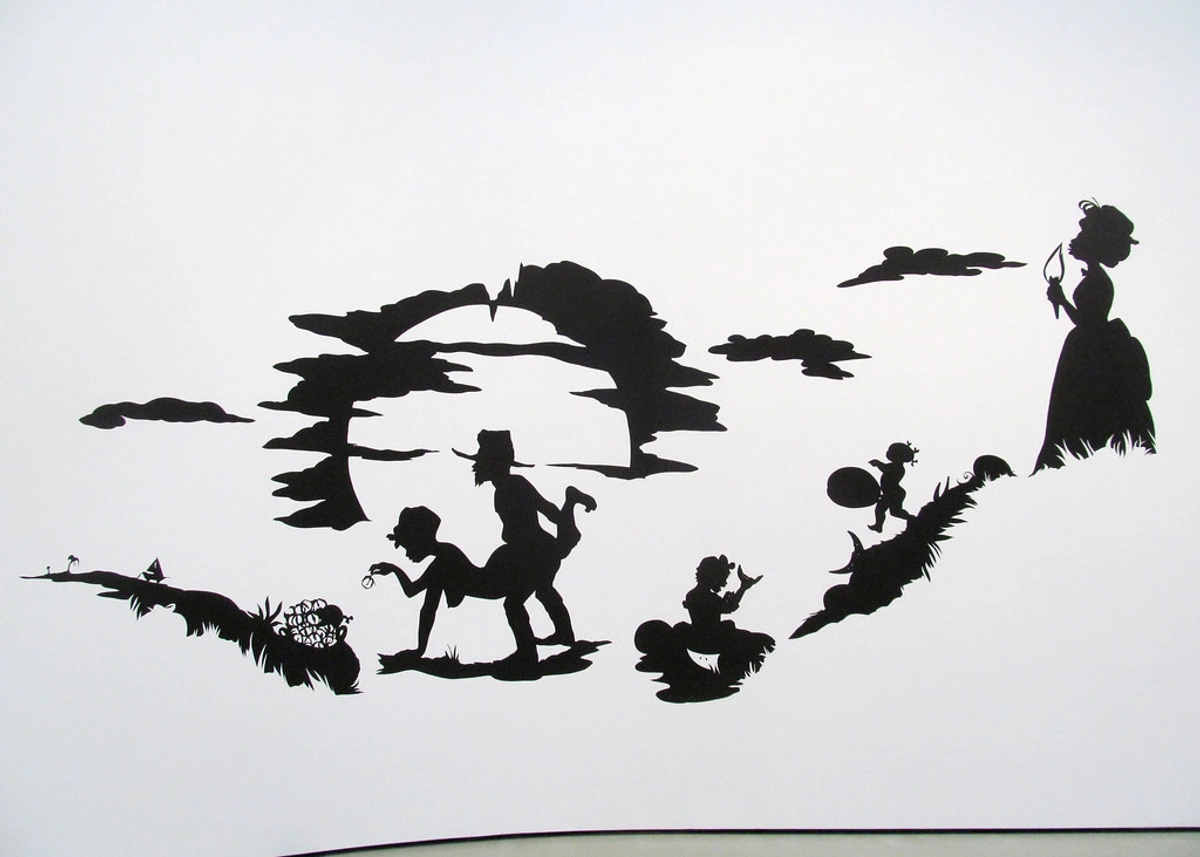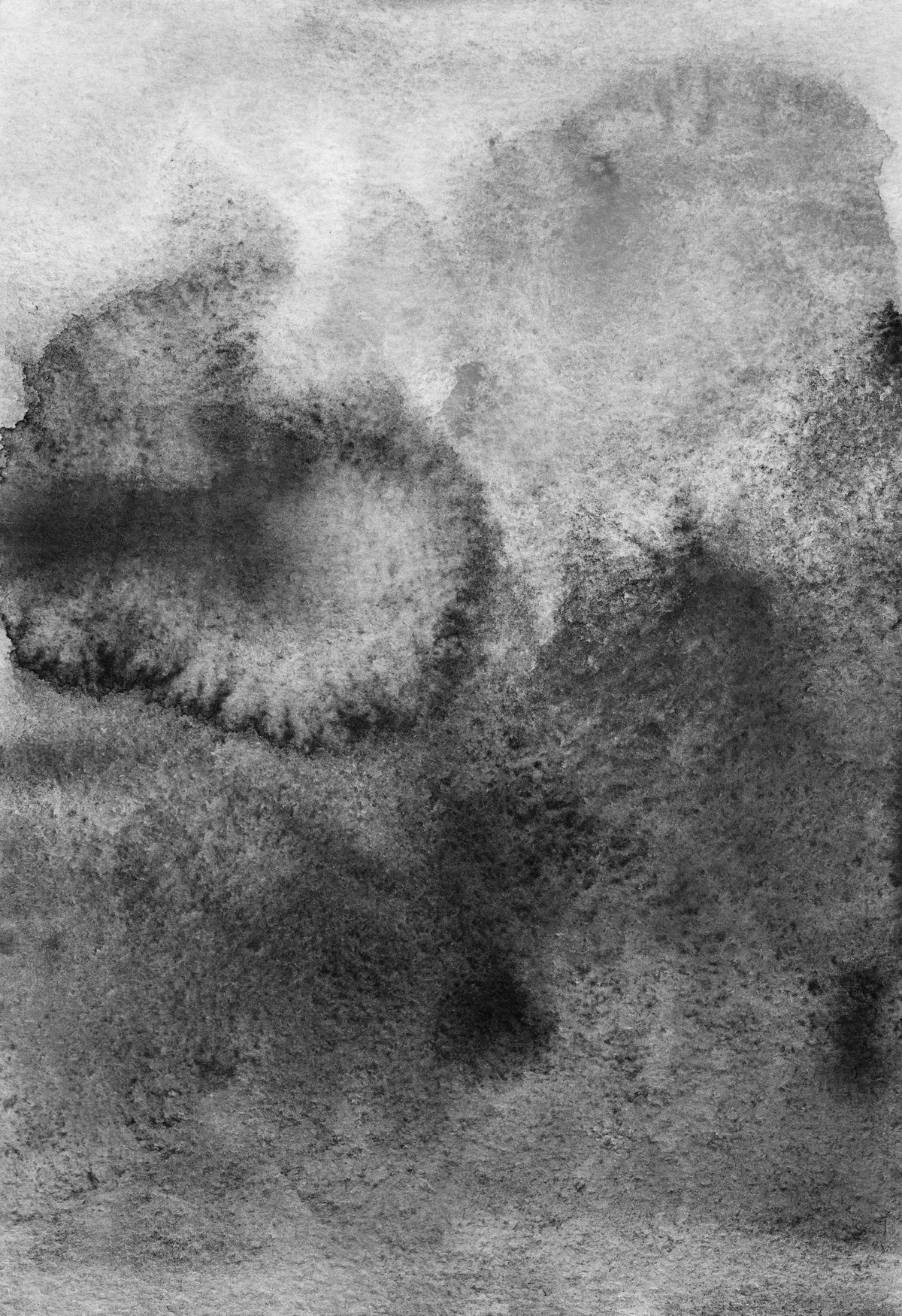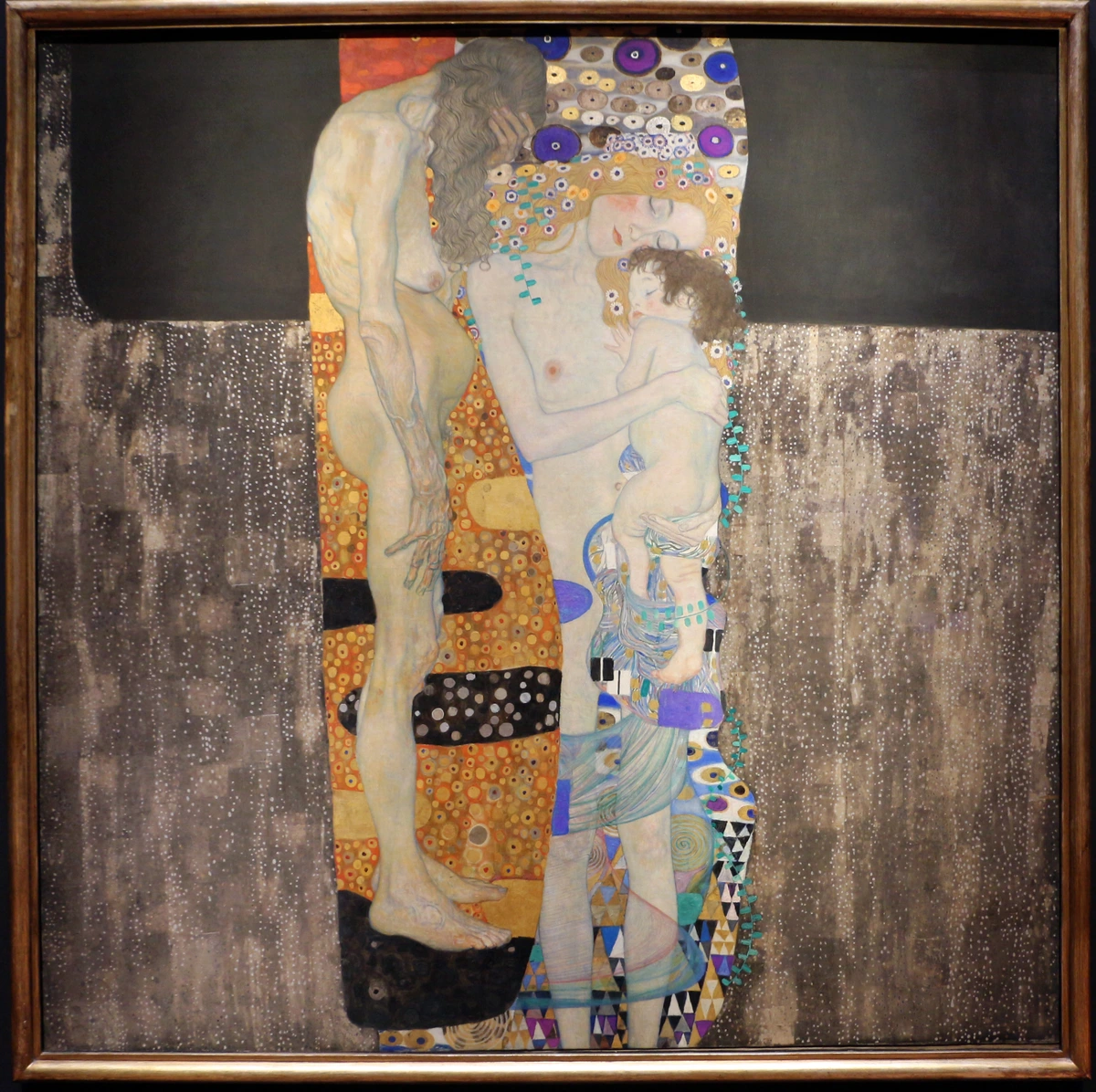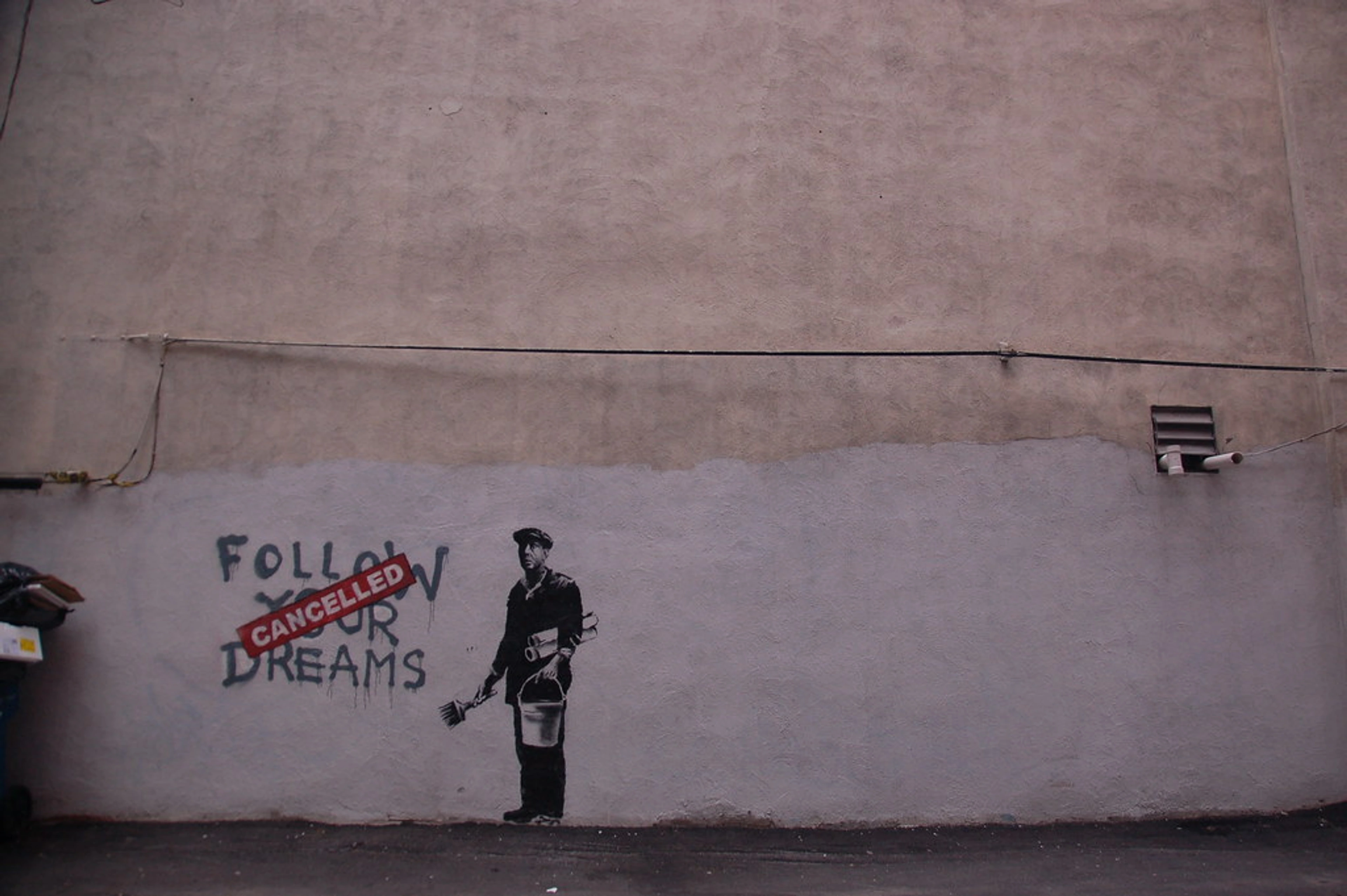
Liberty Leading the People: Decoding Delacroix's Revolutionary Masterpiece
Dive deep into the powerful symbolism and historical context of Eugène Delacroix's iconic painting, 'Liberty Leading the People'. Explore its meaning, characters, and enduring legacy in this comprehensive guide.
Liberty Leading the People: Decoding Delacroix's Revolutionary Masterpiece – An Artist's Deep Dive
Some artworks just hit different, don't they? They don't merely present a scene; they grab you by the soul and plunge you headfirst into a moment of history, defiance, and a burning desire for change. For me, Eugène Delacroix's 'Liberty Leading the People' is precisely that kind of masterpiece. It's more than just pigment on canvas; it's a defiant roar, a rallying cry, a visceral promise painted for the ages. That bare-breasted woman, the French tricolor flag unfurled and whipping in the wind, leading a charge through a chaotic Parisian street – it's an image that's etched itself into the collective consciousness, a universal symbol of the relentless pursuit of freedom. If you're looking to truly understand the heart of revolution and Romanticism, this is where you start. But I think it's also where you start to understand how art itself can become a weapon, a testament, a beacon. This masterpiece, born from the tumultuous July Revolution of 1830, not only captured a pivotal historical moment but also forged an enduring visual narrative that continues to resonate with themes of aspiration, sacrifice, and the unwavering human quest for freedom. It’s a work that challenges us to look beyond the canvas, to the very heart of what it means to fight for a better world.
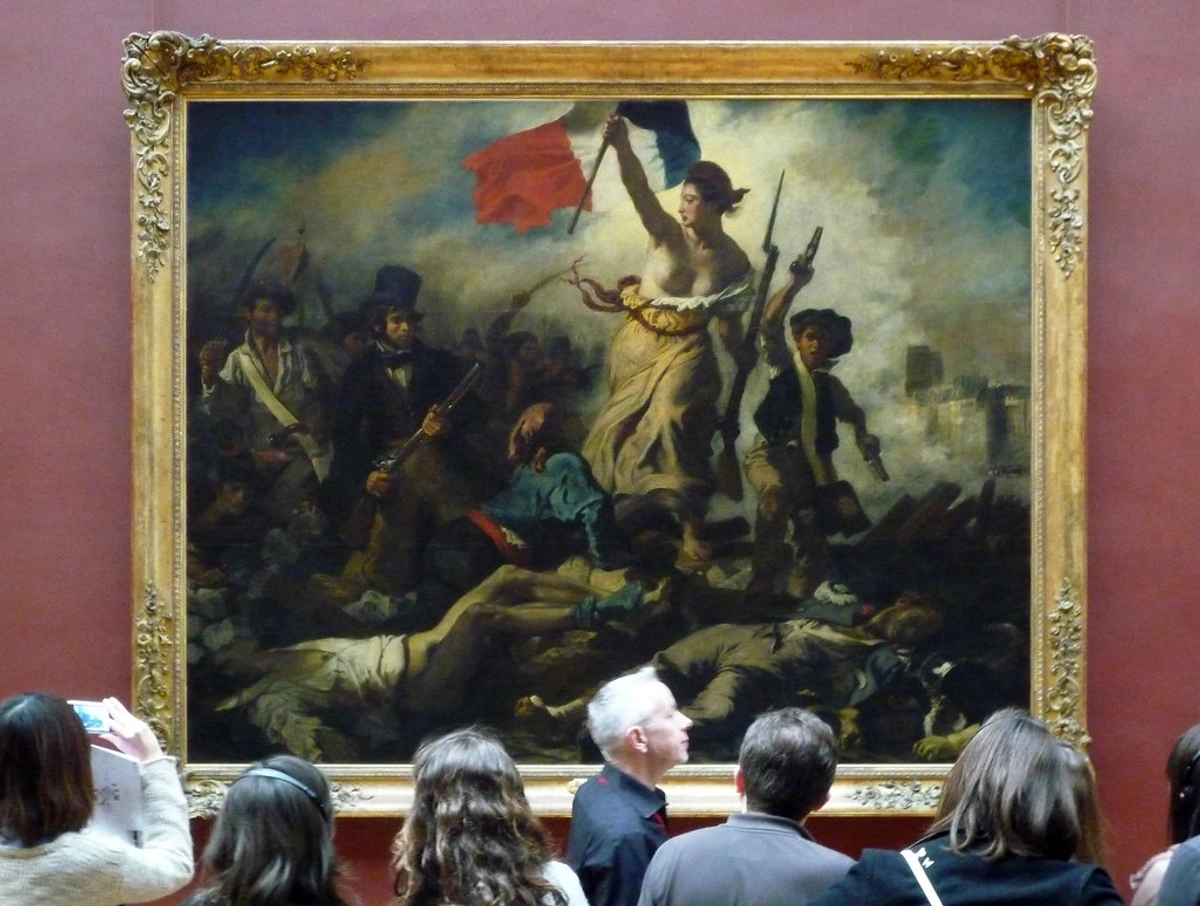
Today, as an artist profoundly moved by its enduring message, I want to take a deep dive into this monumental work. We'll strip back the layers, explore its every brushstroke, and uncover why this iconic painting still resonates so profoundly, echoing the struggles and aspirations that continue to shape our world and even influence my own abstract practice. You know, I've always found it fascinating how a single canvas can encapsulate such a pivotal moment, transforming a specific historical event into a timeless commentary on human aspiration, much like I try to distil complex emotions into abstract forms. We're going to unpack its history, its vibrant symbolism, and the lasting legacy of a work that, quite frankly, changed everything. Consider this your definitive guide, a journey into the soul of a revolution, seen through the eyes of a master and, perhaps, a fellow traveler in the realm of artistic expression.
The Spark of a Revolution: History on Canvas
Let's truly set the stage for Delacroix's masterpiece. The air in Paris was thick with discontent, a palpable tension humming beneath the surface of the city. This wasn't just 1830; it was part of a broader wave of revolutionary fervor sweeping across Europe, often referred to as the 'Restoration Era' after the fall of Napoleon. It was a period marked by a constant push-and-pull between the old aristocratic order, desperately clinging to power, and the rising tide of liberal and nationalist sentiments. Across the continent, secret societies and public demonstrations alike yearned for greater self-determination, constitutional governance, and an end to absolute monarchies. The ideals of the first French Revolution – liberty, equality, fraternity – were not dead; they were simply simmering, waiting for the right spark. And that spark, as it often does, came from political overreach.
Just 40 years after the initial French Revolution, the people were once again fed up with monarchical overreach. King Charles X, a staunch conservative and a leading figure of the ultraroyalist faction, had been systematically attempting to roll back the liberal reforms gained in the wake of the earlier revolution. He harbored a deep desire to restore the absolute monarchy that had been dismantled by the first French Revolution, effectively ignoring the seismic shifts in societal expectations and the new political consciousness of the people. His infamous July Ordinances, enacted on July 26, 1830, were the final, fatal gamble. Issued without consulting the newly elected parliament, these decrees severely curbed press freedom, dissolved the newly elected Chamber of Deputies even before it could convene, and drastically restricted voting rights, effectively disenfranchising a large segment of the already limited electorate. These classic moves, aimed at silencing dissent and consolidating power, consistently show us that history has a way of repeating itself, never ending well for those who ignore its lessons. The popular backlash was swift and fierce, fueled by a growing urban working class – laborers, artisans, and tradesmen – who faced harsh economic conditions, and an increasingly vocal liberal bourgeoisie, comprised of merchants, lawyers, and intellectuals, who saw their hard-won political freedoms evaporating. It was a pressure cooker waiting to blow, and Charles X, it seems, was intent on turning up the heat, unwittingly igniting the very revolution he sought to prevent.

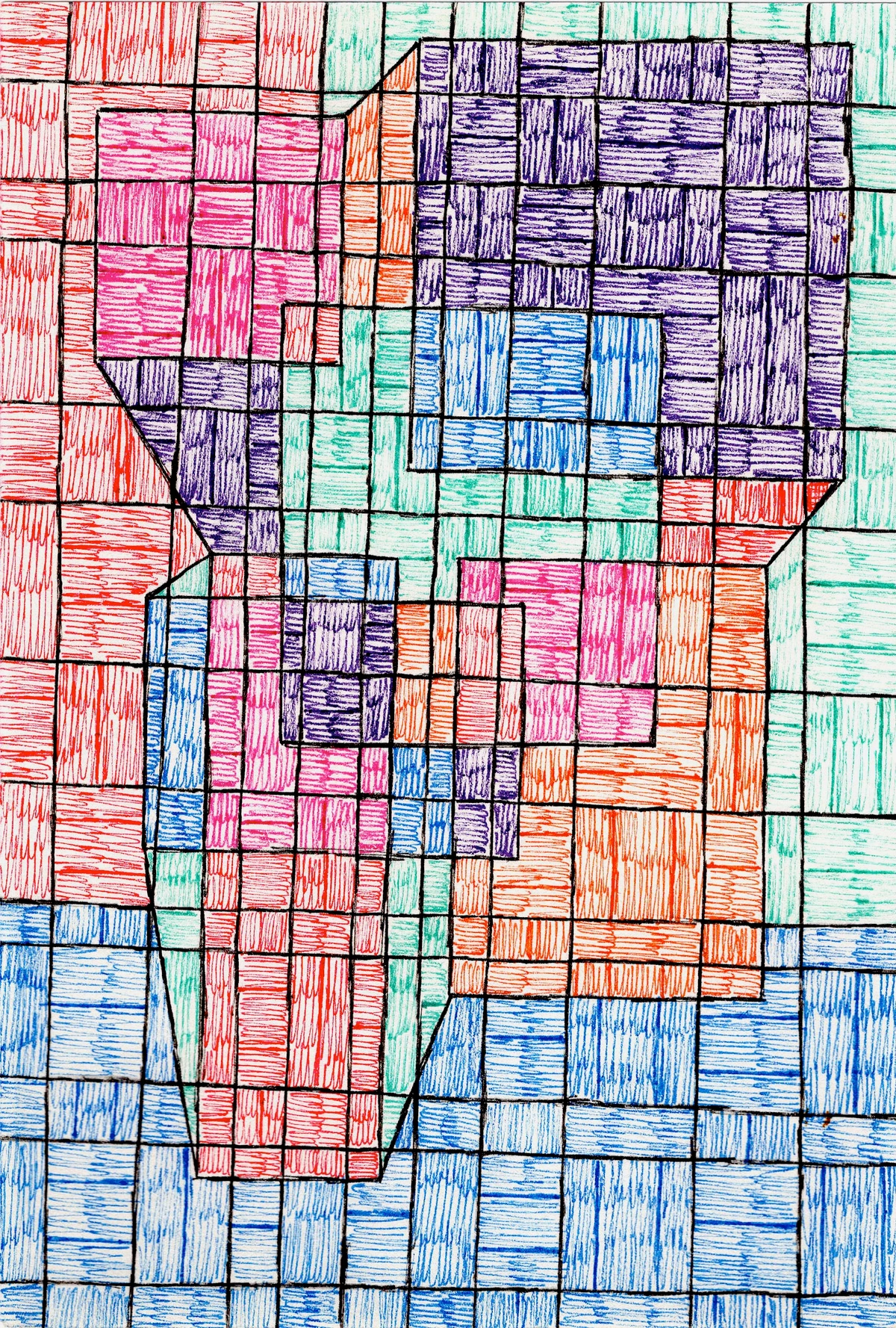
In July, the streets erupted. For three glorious, bloody days, from the 27th to the 29th – often referred to as "Les Trois Glorieuses" (The Three Glorious Days) – Parisians fought heroically on the barricades, a true testament to the power of collective will. Citizens from all walks of life, energized by a shared outrage, poured into the streets, transforming the city into a battleground. And guess what? They won. Charles X was out, his reign abruptly ended, and a new 'Citizen King,' Louis-Philippe, was installed, marking a significant shift in French political landscape. The July Monarchy, while initially seen as a more liberal alternative, would also face its own challenges and eventually fall, proving that revolutions often beget further political evolution, sometimes peacefully, sometimes not.
The Immediate Aftermath: A New King, New Hopes, New Tensions
The triumph of the "Trois Glorieuses" was intoxicating, but the immediate aftermath was a complex mix of relief, celebration, and underlying political tensions. With Charles X's abdication, the revolutionary leaders, primarily drawn from the liberal bourgeoisie, quickly moved to establish a new government. Their choice was Louis-Philippe I, Duke of Orléans, a distant cousin of the deposed king. He was presented as the "Citizen King," chosen by the people, and his reign inaugurated the July Monarchy.
Initially, this seemed like a victory for liberal ideals. Louis-Philippe adopted the tricolor flag (a symbol of the 1789 Revolution) instead of the Bourbon white standard, and promised a more constitutional, less absolutist rule. However, the hopes of the working classes and more radical republicans for truly democratic reforms were soon tempered. The July Monarchy, though more liberal than its predecessor, largely favored the interests of the wealthy bourgeoisie, leaving many of the working-class revolutionaries feeling betrayed and their sacrifices unrewarded. This simmering discontent would eventually lead to further uprisings, proving that the flame of revolution, once lit, is not easily extinguished, and that political evolution is often a long, arduous process with many detours. It’s a powerful lesson in how even victories can carry the seeds of future struggles.
Delacroix, a direct witness to these electrifying events, felt an irresistible compulsion to paint, driven by a profound sense of civic duty and artistic inspiration. Like many Romantics, he believed art had a vital role in society, not just to reflect, but to actively participate in and shape public consciousness. He famously wrote to his brother, "I have undertaken a modern subject, a barricade, and if I have not won for my country, at least I will paint for it." That, to me, perfectly captures the spirit of art in response to seismic events – not just documentation, but interpretation, passion, and a form of patriotic contribution. It’s like saying, "I might not be on the front lines, but I'm fighting with my brush." Delacroix, a leading figure of the Romantic art movement, wasn't just observing; he was internalizing, channeling the raw emotion and drama of the streets onto his canvas with a passionate intensity. He felt a profound personal connection to the ideals of liberty and national pride, seeing his art not merely as documentation but as an active contribution to the nation's struggle. This profound sense of civic duty, combined with his burgeoning mastery of Romantic expression, allowed him to move beyond mere reportage, capturing the feeling of a nation demanding its rights. This wasn't merely documentation; it was a deeply personal and political statement, forging a link between artistic creation and national destiny, elevating the fleeting moment to a timeless epic. It’s a fascinating contrast to how art movements like those in The Ultimate Guide to Abstract Art Movements: From Early Pioneers to Contemporary Trends react to societal shifts today. The revolution itself was a complex tapestry of various social classes uniting against perceived tyranny, a theme Delacroix masterfully wove into his composition, making it a powerful testament to collective will.

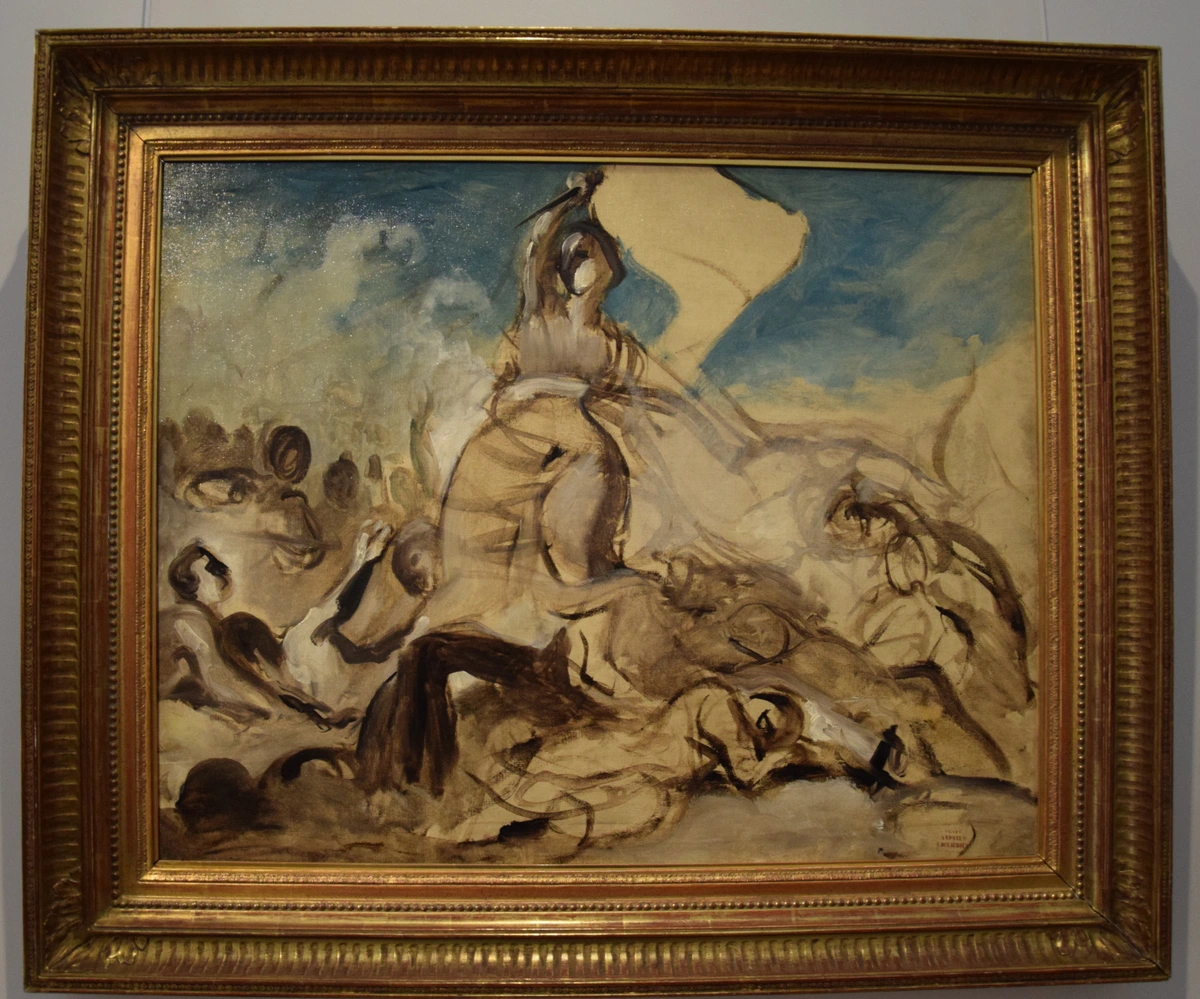
His commitment wasn't just to the scene, but to the ideal. He poured his soul into depicting the raw energy and patriotic fervor of those July days. For an artist, watching society unravel and then rebuild, sometimes violently, offers an incredible, albeit terrifying, wellspring of inspiration. It makes you confront your own role, doesn't it? My own timeline as an artist, for instance, shows how different influences can converge to form a cohesive vision – albeit with far less bloodshed!
The Salon of 1831: Public Debut and Critical Divide
When 'Liberty Leading the People' was first unveiled at the Salon of 1831, it ignited a storm of passionate debate. On one hand, many within the liberal circles and among the populace celebrated it as a powerful, patriotic depiction of their recent triumph. They saw in Marianne a potent symbol of their aspirations and in the diverse crowd a reflection of their unity.
However, the artwork also provoked considerable scandal and outrage, particularly among conservative critics and the more genteel segments of society. The stark realism, especially the bare-breasted Marianne and the depiction of gritty street fighters, was deemed too vulgar, too uncouth for traditional academic art. Critics steeped in Neoclassical aesthetics found its dynamism chaotic, its subject matter lacking in classical decorum, and its emotional intensity overwhelming. They were accustomed to art that presented idealized, sanitized versions of history, not the visceral, sweat-and-blood reality of a contemporary street battle. The government itself, after initially purchasing the painting as a gesture of support for the new July Monarchy, quickly grew uneasy with its incendiary power, fearing it might incite another rebellion. They quietly removed it from public display, effectively censoring it and storing it away for many years. Can you imagine a piece of art being so potent it frightens those in power? It really speaks to the idea of Art as Catalyst for Social Change, doesn't it?
The Monumental Ambition: A Painting of Grand Scale
'Liberty Leading the People' isn't just a painting; it's a monumental statement, both in its subject matter and its physical dimensions (approximately 2.6 meters high and 3.25 meters wide). Delacroix didn't just capture a scene; he transformed a contemporary event into an epic, historical drama worthy of the grandest canvases, a radical departure from the academic tradition that typically reserved such scale for classical or mythological subjects. This audacious choice of scale immediately elevates the revolution from a localized uprising to a universal struggle for freedom, demanding the viewer's full attention and immersion. It’s a bold assertion of art’s capacity to shape public memory and inspire future generations, cementing the event's place in history as more than just a fleeting moment of unrest. This ambition resonates deeply with my own desire to create art that truly makes an impact, transforming the personal into something universal, and it underscores the power of a grand gesture in art.
Delacroix's Early Life and Artistic Formation
Eugène Delacroix (1798–1863) was no stranger to political turmoil; in many ways, he was a child of revolution. Born just a few years after the height of the first French Revolution, he grew up in a France constantly reshaped by political upheaval and the lingering echoes of revolutionary ideals. Imagine being steeped in a world where the very fabric of society was constantly being rewoven! His early artistic training, including time with Pierre-Narcisse Guérin, a prominent Neoclassical painter, initially steeped him in the rigorous traditions of Jacques-Louis David and his followers, emphasizing meticulous draftsmanship, classical restraint, and a focus on historical and mythological subjects. This foundation provided him with a strong technical base, honing his abilities in anatomy and composition. However, let's be honest, Delacroix's fiery temperament and burgeoning interest in color and emotion were never going to be confined by cool marble logic or academic dogma for long.
His burgeoning fascination with vibrant color, dramatic compositions, and exotic subjects quickly steered him towards what would become the Romantic movement. He found the cool logic of Neoclassicism insufficient to express the tumultuous world around him, the internal passions he felt, and the grand, sometimes terrifying, scale of human emotion. Early works like The Barque of Dante (1822), a visceral exploration of a dramatic scene from Dante Alighieri's Inferno teeming with tormented souls and turbulent waters, and The Massacre at Chios (1824), a powerful depiction of contemporary Greek suffering at the hands of the Ottoman Empire, already showcased his radical departure from rigid academicism. These paintings embraced intense emotion, dynamic narrative, and a painterly approach that reveled in visible brushstrokes, signaling his commitment to capturing the feeling of a moment rather than its mere factual representation. Liberty Leading the People was a natural culmination of this artistic evolution, a canvas where his personal passion for freedom converged with his burgeoning mastery of Romantic expression. It’s fascinating how an artist’s personal history and the era they live in so profoundly shape their most iconic works, isn’t it? It makes me think about my own timeline as an artist, how different experiences push you in new directions.

Marianne: The Unforgettable Allegory of Liberty
The central figure, the one who grabs your eye immediately and never lets go, is Marianne. She's not a real person, obviously; she's an allegory, a living, breathing (or rather, vividly painted) symbolic representation of Liberty itself and, by extension, France. Think about that for a second: to personify such a huge, abstract concept, to give it such a compelling, dynamic form – it’s a stroke of absolute genius. She strides purposefully, almost defiantly, over the dead and dying, a musket clutched in one hand, the glorious French tricolor flag proudly unfurled and whipping in the other. She embodies an ideal, an aspiration, made flesh (or paint). Her bare breast isn't there for titillation, though let's be honest, it probably raised a few eyebrows then, and still does now! Instead, it's rich with classical and allegorical meaning. It symbolizes freedom in its purest, most unconstrained form – a wild, untamed spirit of the republic, raw and untamed by the rigidities of societal convention. This classical allusion harks back to ancient Greek and Roman depictions of goddesses and allegorical figures, who were often presented seminude to convey a timeless, divine purity and power that transcends the mundane, suggesting a universal, rather than merely human, ideal. It’s also a powerful symbol of nurturing – a maternal figure, Mother France, ready to fight for her children, a protector of the people. Yet, she is also defiant, strong, and unbowed, embodying the fierce resolve of a nation. Marianne herself, as an emblem of France, has a rich and evolving history that truly blossomed during the French Revolution of 1789, quickly becoming a symbol of the newly established Republic, embodying its ideals of Liberty and Reason. Though Delacroix didn't invent Marianne, her presence in his painting, particularly her dynamic, idealized form, undeniably solidified her iconic status. He transformed her into the definitive visual shorthand for the French nation's soul, breathing life into an abstract concept. Her image has since appeared in countless forms throughout French history – from sculptures adorning town halls to postage stamps, coins, official government logos, and even as busts in every French mayoral office – always embodying the spirit of the Republic and its enduring values. Her enduring presence is a testament to the power of allegorical art to shape national identity.
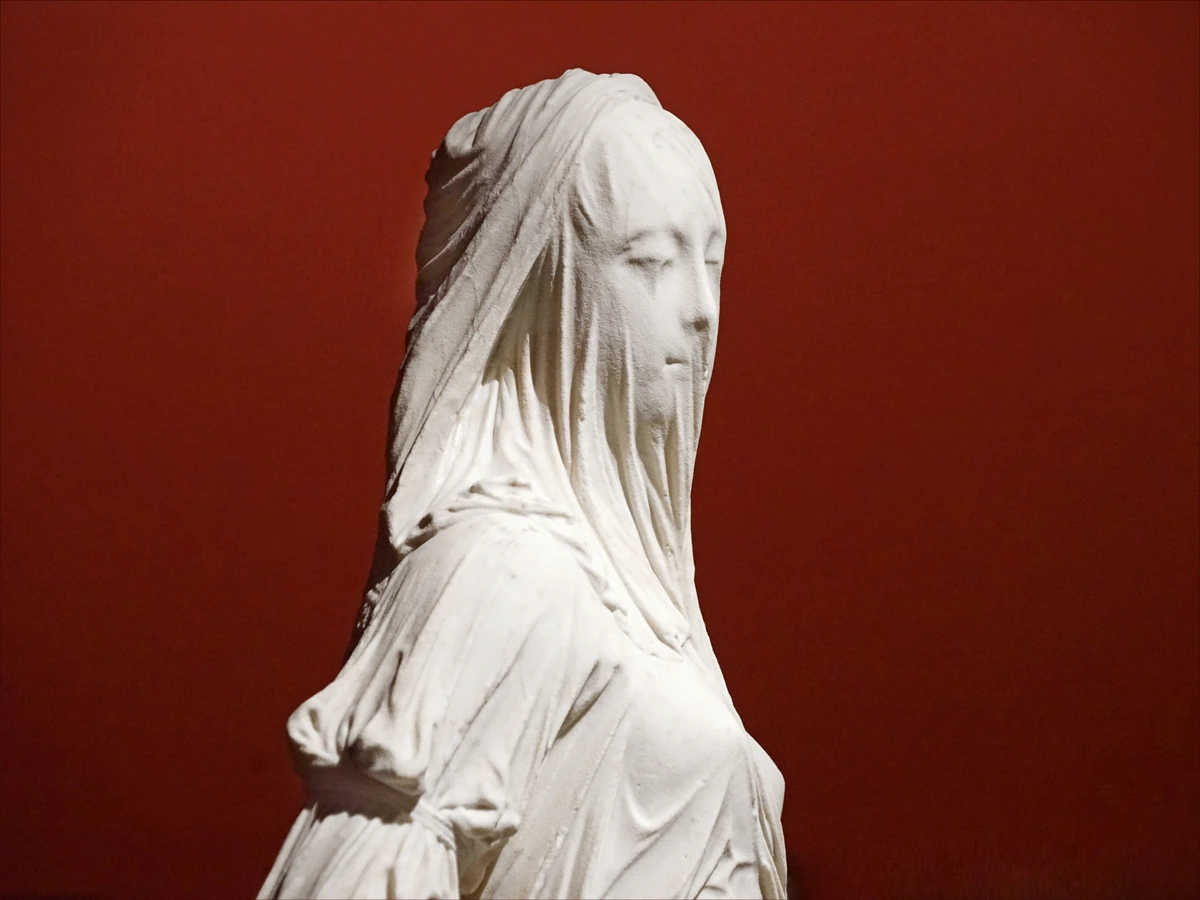
The People: A Kaleidoscope of Society United
What truly elevates this painting, beyond Marianne herself, is the diverse cast of characters around her. Delacroix didn't just paint generic revolutionaries; he painted the people – all of them, united in a common cause. Look closely:
- *** The Bourgeois Man: Look closely at the man in the top hat, rifle in hand. This figure, often identified as a self-portrait of Delacroix himself or his close friend Etienne-Jean Delécluze, is critically important. His presence, dressed in refined attire amidst the chaos, represents the educated middle class – the bourgeoisie – who, despite their comfortable lives, also felt compelled to join the fight for political freedom. This isn't just a street brawl; it’s a unified uprising that transcended narrow class interests. It’s a powerful statement: this revolution was for everyone, not just one segment of society, highlighting the widespread discontent and the desire for political reform that cut across class lines. It reminds me that even those with much to lose can be driven by a greater ideal.
- The Gamin (Street Urchin/Boy with Pistols): My favorite, perhaps. This audacious young boy, often romantically linked to the character of Gavroche from Victor Hugo's epic novel Les Misérables (though the novel was published decades later, the archetype of the fearless Parisian street urchin certainly existed), brandishes two pistols, rushing forward with an almost feral, utterly fearless determination. His inclusion is a stroke of genius, representing not just youthful rebellion and the raw, untamed spirit of the Parisian streets, but also the potent idea that freedom is worth fighting for at any age, even if you're barely old enough to hold a weapon. He’s the future, fearless and untamed, charging ahead without a thought for personal safety, embodying pure revolutionary zeal and the enduring hope for a better tomorrow, a symbol of the innocent yet fierce determination of the next generation.
- The Worker/Fighter: To Marianne's immediate left, a brawny man in a working-class shirt and a factory worker's cap (that ubiquitous Phrygian cap, a subtle but vital reinforcement of his revolutionary allegiance) holds a sabre, his gaze fixed upwards on Liberty with a mixture of awe and fierce devotion. He's the muscle, the labor, the very backbone of the revolution, a testament to the working class’s crucial role, his powerful physique underscoring the physical force of the uprising. He is the raw, visceral power of the people, fighting for a tangible change in their daily lives, embodying the relentless struggle for dignity and better conditions. His muscularity and active stance further emphasize the physical demands and brute force inherent in street combat.
- The Fallen: In the visceral foreground, strewn across the makeshift barricade, are the bodies of fallen soldiers and revolutionaries, a poignant reminder of the grim toll of conflict. Their sacrifice is incredibly poignant, grounding the heroic idealism of Marianne with the brutal reality of war. Delacroix deliberately includes figures from different social strata – such as a fallen National Guardsman, a worker, and a student – emphasizing that the cost of liberty is borne by all. One figure, shockingly stripped of his pants and shirt, serves as a stark, unforgettable reminder of the indignity, vulnerability, and sheer brutality of war, a symbol of the ultimate human cost. These fallen figures force us to confront the devastating consequences of even the most noble aspirations, injecting a profound sense of realism and gravitas into the heroic narrative. This isn't some sanitized fantasy; it's a brutal truth, painted with unwavering honesty, reminding us that every revolution carries a heavy burden of loss.
This isn't just a mob; it's a dynamic, breathing cross-section of Parisian society, temporarily united, despite their differences, by the singular, burning pursuit of liberty. It reminds me of how, sometimes, it takes a truly grand, unifying idea to bring disparate groups together. This meticulously assembled group highlights Delacroix's intention to show a 'people's' revolution, encompassing all strata of society, united by a common, burning desire for liberty.
The Barricade: A Symbol of Popular Uprising
The very foundation upon which Marianne and her revolutionaries surge forward – the barricade – is itself a powerful symbol of popular uprising in French history. These makeshift fortifications, often constructed from overturned carts, furniture, paving stones, and anything else at hand, were a characteristic feature of Parisian revolts, including the July Revolution of 1830.
Delacroix's depiction of the barricade isn't merely background detail; it's a testament to the ingenuity and collective action of the populace. It represents the literal ground upon which the revolution was fought, a physical manifestation of defiance against authority. The jumble of objects – broken carts, paving stones, discarded weapons – speaks to the spontaneous, organic nature of the uprising and the willingness of ordinary citizens to repurpose their everyday environment into instruments of rebellion. It underscores the idea that revolution is not just fought by soldiers, but by the people themselves, transforming their city into a battleground for freedom. This visual element grounds the allegorical ideals of liberty in the gritty, tangible reality of urban warfare.
More on the Phrygian Cap: An Ancient Symbol Reborn
The Phrygian Cap, worn by the worker/fighter and a prominent symbol throughout the French Revolutions, holds immense historical weight. Its origins trace back to antiquity, where it was worn by freed slaves in Rome, thus becoming a potent emblem of emancipation and liberty. Its adoption during the French Revolution of 1789 further solidified its status as a radical symbol, often referred to as the "cap of liberty." In the context of "Liberty Leading the People," its inclusion immediately identifies the wearer as a revolutionary fighting for freedom from oppression, linking the present struggle to a long history of liberation and republican ideals. It’s a subtle yet powerful detail that reinforces the painting's core message: that the fight for freedom is a timeless one, echoing through centuries and connecting movements for liberation across different eras. When I see symbols like this, I'm reminded of how potent simple forms can be, how they can carry layers of meaning across generations and across diverse political landscapes.
Key Figures and Their Allegorical Roles
Figure | Description | Allegorical Role |
|---|---|---|
| Marianne (Liberty) | The central, bare-breasted woman, holding the tricolor flag and a musket, leading the charge. | Embodies the abstract ideal of Liberty and the French Republic itself; a timeless, powerful symbol of freedom and defiance. |
| Bourgeois Man | The man in the top hat, potentially a self-portrait or friend of Delacroix, holding a rifle. | Represents the educated middle class, showing that the revolution was not solely a working-class movement, but a unified effort across social divides. |
| Gamin (Street Urchin) | The audacious young boy with two pistols, rushing forward. | Symbolizes youthful rebellion, the raw, untamed spirit of the Parisian streets, and the future generation willing to fight for freedom. Often associated with Gavroche from Les Misérables. |
| Worker/Fighter | The brawny man in a working-class shirt and Phrygian cap, holding a sabre. | Represents the crucial role of the working class and laborers, the physical backbone of the revolution, demanding their rights. The Phrygian cap is a direct nod to freed slaves and revolutionary ideals. |
| Fallen Figures | The bodies of soldiers and revolutionaries strewn in the foreground. | Underscores the grim reality and immense human cost of revolution; grounds the heroic idealism of Marianne in the brutal sacrifices made for liberty. Includes a fallen National Guardsman, a worker, and a student. |
The Cost of Freedom: The Grim Reality
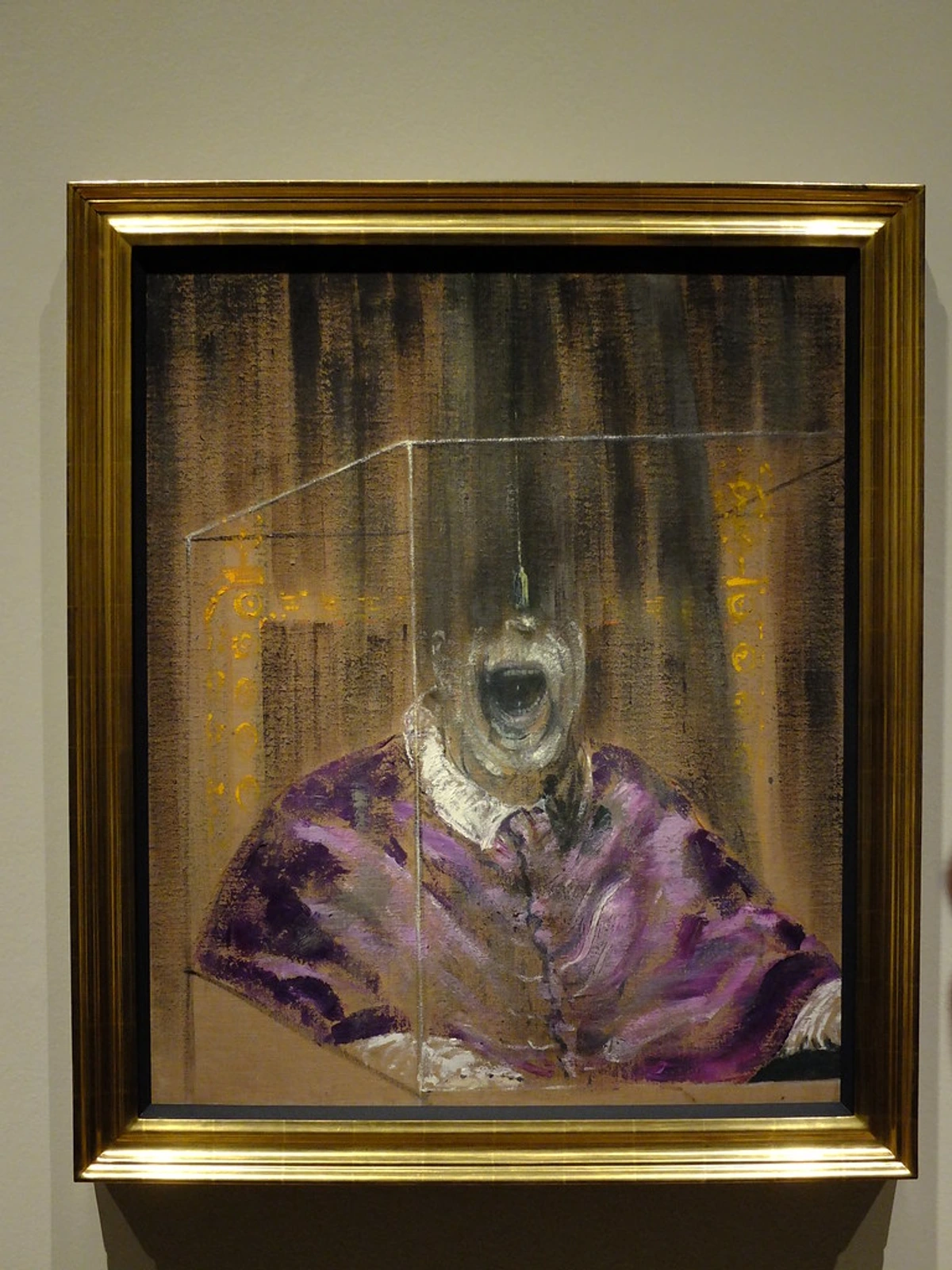
I think one of the most impactful aspects of this painting is Delacroix's unflinching inclusion of the dead and dying. This isn't a sanitized, purely heroic fantasy of war. No, Delacroix doesn't shy away from the horrific consequences of revolutionary fervor. These figures – specifically a fallen National Guardsman (identifiable by his uniform), a stripped worker (representing the vulnerability and indignity of the dead), and a student (often seen as a symbol of intellectual ideals fighting for change) – emphasize that the path to liberty is often paved with immense suffering and loss. Each figure, drawn from a different social stratum, underscores that the cost of freedom is borne by all segments of society. It's a stark, visceral reminder that grand ideals come at a very human price, grounding the heroic idealism of Marianne with the brutal reality of conflict. This powerful narrative choice forces the viewer to acknowledge the human cost, a poignant echo of sacrifices made in every struggle for freedom throughout history. It makes you feel the weight of the moment, the fragility of human life in the face of political upheaval, and the profound sacrifices made for a cause greater than oneself. This raw portrayal injects a profound sense of realism and gravitas, ensuring the painting is not merely triumphant, but also deeply moving and sobering.
Delacroix's Artistic Process: From Sketch to Masterpiece
Creating a work of this scale and emotional intensity was no small feat, even for a genius like Delacroix. Like many masters, he meticulously prepared for Liberty Leading the People through numerous studies and sketches. I've always found these preparatory works fascinating – they're like peering into the artist's mind! These drawings allowed him to refine individual figures, experiment with various compositional arrangements, and capture the dynamic movement of the crowd with precision. His notebook entries and letters reveal an artist deeply immersed in the subject, not just observing, but internalizing the raw energy of the revolution, almost becoming a part of it. He experimented with color relationships and light effects on smaller canvases, carefully planning his palette to maximize dramatic impact and emotional resonance. The use of swift, energetic brushstrokes – a hallmark of Romanticism – further amplified the sense of urgency and movement on the canvas, almost as if the paint itself is alive and moving, contributing to the palpable sense of chaos and fervor. This commitment to process, from initial conceptualization to the final brushstroke, is a hallmark of true artistic dedication, a dedication I resonate with deeply in my own, albeit very different, abstract journey. It's about letting the vision evolve, isn't it? It's about that relentless pursuit of capturing an idea, a feeling, a moment, no matter how many iterations it takes.
The Influence of English Painting: A Break from Tradition
While deeply French in its subject, 'Liberty Leading the People' also reveals Delacroix's profound engagement with contemporary English painting. His visit to London in 1825 was a pivotal moment, exposing him to the works of artists like John Constable and J.M.W. Turner. These English Romantic painters were pioneers in their revolutionary use of color, light, and expressive brushwork, departing significantly from the academic norms of the time.
Delacroix was particularly struck by Constable's ability to capture the fleeting effects of light and atmosphere in landscape painting, and Turner's daring, almost abstract use of color to evoke emotion and natural forces. This encounter invigorated Delacroix's own burgeoning Romantic sensibility, pushing him further away from the crisp lines and restrained palettes of Neoclassicism. You can see this influence directly in 'Liberty Leading the People' in his use of vibrant, unblended colors, the dynamic interplay of light and shadow, and the visible, energetic brushstrokes that convey movement and chaos. It was a crucial cross-cultural exchange that helped shape Delacroix's unique vision and cemented his role as a leading innovator in French art.
The Medium is the Message: Oil on Canvas
It's easy to get lost in the narrative and symbolism of 'Liberty Leading the People,' but let's not forget the medium itself: oil on canvas. This was, and remains, the quintessential medium for grand statements in Western art. Oil paints allowed Delacroix an incredible richness of color, a luminosity that few other mediums can achieve, and the ability to create nuanced textures and depth. The slow drying time of oils also afforded him the flexibility to blend colors seamlessly, build up layers, and rework areas, giving the painting its characteristic fluidity and expressive brushwork, perfectly suited to the raw energy of his subject. This expressive handling of paint, a hallmark of Romanticism, allowed him to capture the tumult of the revolution with a visceral immediacy. The sheer scale of the canvas itself (approximately 2.6 meters high and 3.25 meters wide) demanded a physical engagement from the artist, transforming the act of painting into an almost performative act, a dance with the very surface. This physical grandeur contributes immensely to the painting’s monumental impact, literally enveloping the viewer in the revolutionary scene, making it an immersive experience. It's a testament to the enduring power and versatility of this classical medium, even in the depiction of such a radically contemporary subject. It always makes me reflect on how my choice of canvas and paint influences the emotional outcome of my own abstract art – it's never just about the image, is it? It's about the very material that carries the message.
Delacroix and the Romantic Movement: Emotion Unleashed
Before we dive deeper into the individual symbols, let’s talk a little more about the artistic currents that shaped Delacroix and this magnificent work. He was, without a doubt, the undisputed master of Romanticism in France – an art movement that, to me, feels like a dramatic sigh of relief after the rigid rules of Neoclassicism. Where Neoclassicism prioritized order, reason, and classical forms (think cool marble statues and perfectly balanced compositions, often drawing on ancient Greek and Roman themes for timeless moral lessons, as seen in works by Jacques-Louis David like The Oath of the Horatii), Romanticism burst forth with emotion, individualism, the sublime, and a fascination with the exotic and the dramatic. It was a visceral, impassioned response to the Enlightenment's emphasis on pure rationality, arguing that the human experience was far richer and more complex than logic alone could explain. It was about feeling over thinking, passion over logic, and the profound, often turbulent, inner life of the individual. And when I say inner life, I mean the full spectrum – from awe to terror, from triumph to despair.
Delacroix wasn't afraid of the messy, the intense, the deeply human. You can see all the hallmarks of Romanticism vividly in 'Liberty Leading the People': its emphasis on raw, untamed emotion takes precedence over cool rationality; the focus shifts to the heroic individual (even an allegorical one) and their struggle; it embraces the sublime – that awe-inspiring, sometimes terrifying, beauty of both nature and human experience; the dynamic composition and vibrant color palette replace static, restrained forms; and crucially, artists engaged with contemporary events and social issues, elevating them to epic narratives. While some Romantics yearned for distant lands or idealized historical periods, Delacroix chose a very contemporary 'history painting,' injecting immediate relevance into a grand tradition, a bold move that shattered academic conventions.
'Liberty Leading the People' is, in essence, a Romantic manifesto on canvas. It’s got all the hallmarks: intense emotion, a contemporary political event elevated to epic proportions through its allegorical figure and dramatic composition, a heroic allegorical figure embodying grand ideals, and a composition designed to sweep you into the drama. It’s a far cry from the serene, idealized scenes of Jacques-Louis David, isn't it, with his emphasis on clear lines and moralizing fables? David's heroes were often stoic and restrained; Delacroix's are passionate and raw. It's raw, it's immediate, it's alive. This embrace of feeling and individual expression is something I deeply connect with in my own abstract work, where the goal is often to evoke, rather than merely represent. It's also why I'm drawn to movements like Ultimate Guide to Expressionism, which similarly prioritize emotional impact over strict realism.
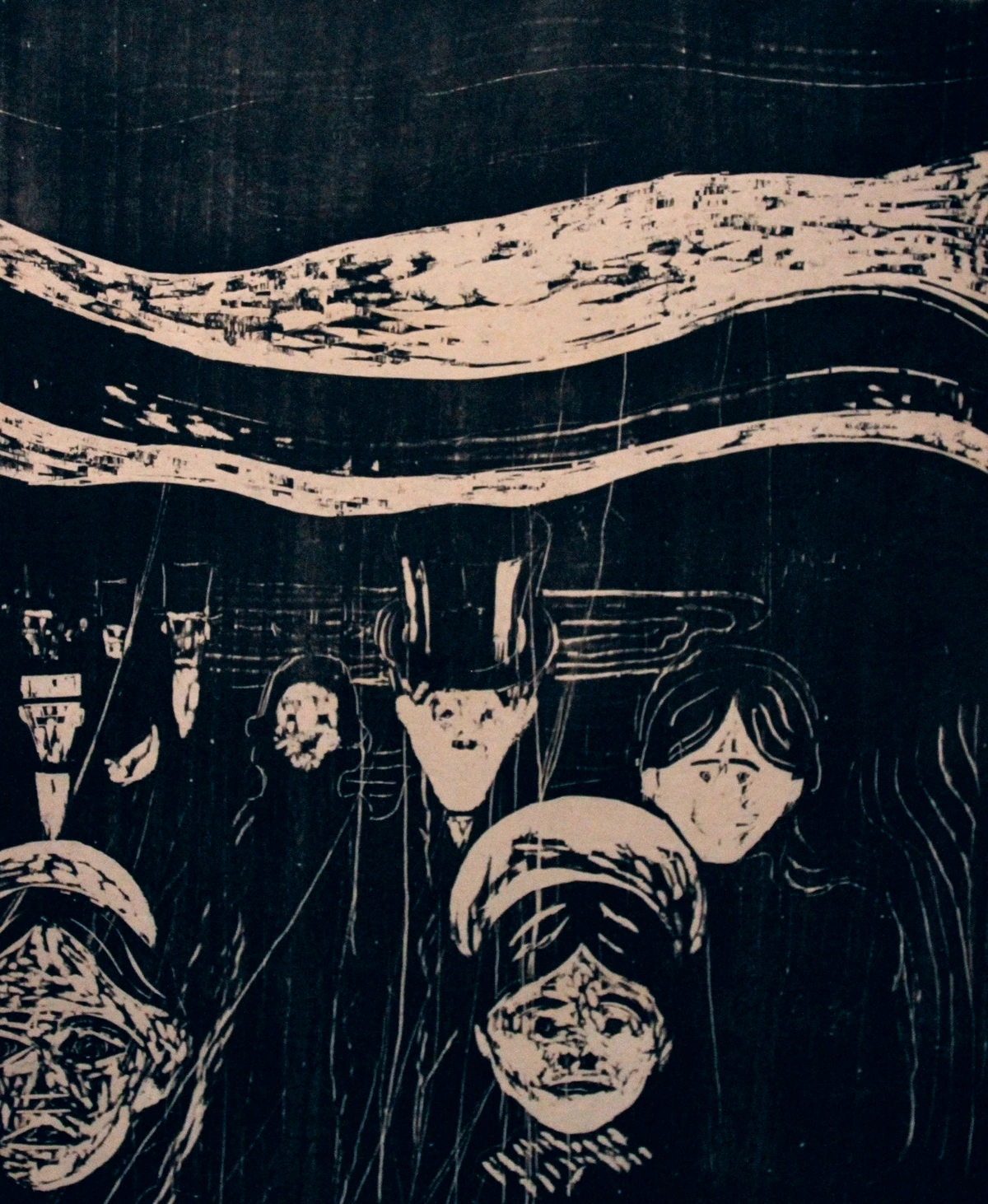
Symbolism in Every Brushstroke
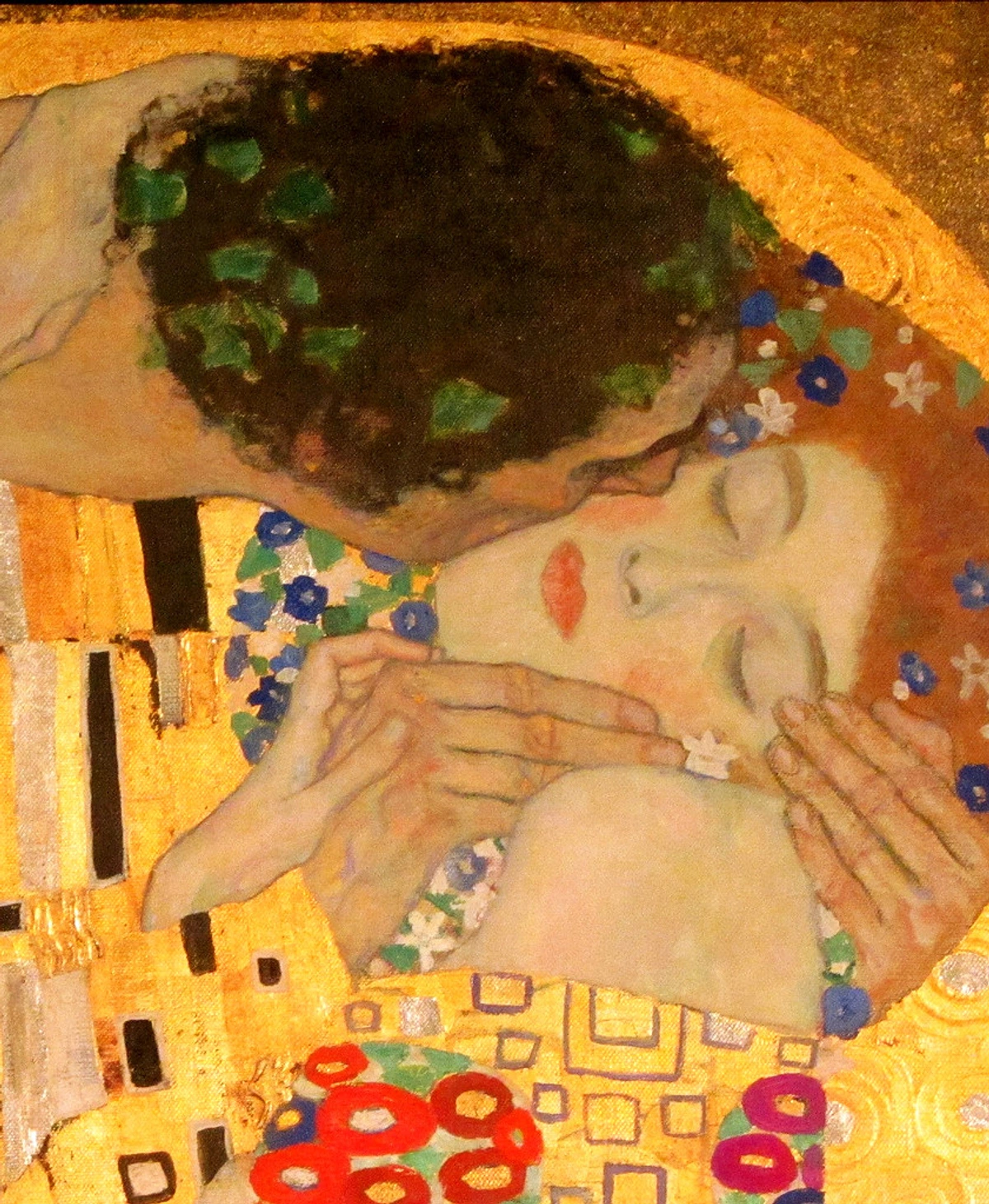
Delacroix was a master of Romanticism, an art movement that prioritized emotion, drama, and individualism over the cold rationality of Neoclassicism. And boy, does this painting deliver on all fronts. Beyond the figures, every element is steeped in meaning, creating a rich tapestry of visual narrative that speaks volumes about the revolutionary spirit and its costs:
- The French Tricolor Flag: This isn't just any flag; it's the very emblem of the revolution, a powerful symbol of the republican ideals of liberty, equality, and fraternity. Marianne holds it aloft, its red, white, and blue vibrant and almost glowing against the smoky, chaotic backdrop, a beacon of hope and defiance. It’s the banner under which a new France is being forged.
- Notre Dame Cathedral: In the hazy, smoke-filled distance, if you squint, you can just make out the iconic towers of Notre Dame Cathedral, proudly flying the tricolor flag. Its presence is absolutely vital; it’s an enduring, centuries-old symbol not just of Paris, but of France itself, its history, its religious tradition, and its cultural identity. Its inclusion roots the tumultuous revolutionary action in a specific, historical, and deeply French context, subtly reminding us that even amidst radical change and destruction, some things stand firm. At the time of the July Revolution, Notre Dame, though an ancient monument, was very much part of the living, breathing city, a silent, powerful observer bearing witness to the birth of a new era and the ongoing struggle for national identity. This interplay of ancient institution and modern revolution adds a profound layer of meaning to the canvas, suggesting a continuity of spirit even through rupture, a France reborn but still connected to its deep heritage.
- Smoke and Chaos: The swirling, hazy smoke, the jumble of bodies and discarded weapons on the barricade – these elements aren't just details; they convey the visceral, suffocating reality of battle, the dust, noise, and sheer confusion of revolution. Yet, miraculously, through it all, Liberty remains clear and resolute, almost divinely illuminated, a steadfast beacon cutting through the pandemonium, emphasizing her unwavering resolve amidst turmoil.
- Dramatic Lighting and Composition: Delacroix's compositional genius is on full display. The painting uses a strong pyramidal composition, with Marianne, majestic and powerful, forming the apex. This structure doesn't just draw your eye upwards, reinforcing her heroic, almost deified status; it also provides a sense of powerful upward thrust, a surge of hope, a visual representation of progress and aspiration. The dynamic diagonals created by the figures—from the fallen in the foreground leading up to Marianne and the flag—create a powerful sense of forward momentum. This careful arrangement, a masterclass in understanding-balance-in-art-composition, ensures the viewer's eye is always in motion, swept along with the revolutionaries. The dramatic lighting, a hallmark of Romanticism and indeed, a technique perfected in earlier movements like the ultimate-guide-to-baroque-art-movement, highlights key figures with almost theatrical intensity, creating a sense of urgent, unstoppable movement. Your eye is drawn from the fallen bodies in the foreground, up the diagonal lines of the revolutionaries, culminating in the illuminated figure of Marianne and the vibrant flag she holds aloft. It's a composition that doesn't just show you the revolution; it pulls you right into the thick of it, making you feel the push and pull of the fight, the very momentum of history unfolding. This interplay of dark and light, known as chiaroscuro, adds immense depth and emotional weight, elevating the scene to an almost mythical struggle, making the viewer a participant rather than a mere observer.
The Power of Delacroix's Palette: Color and Light as Emotional Tools

Beyond the compositional structure, Delacroix's masterful use of color and light is what truly ignites the painting's emotional core. He wasn't just filling in outlines; he was sculpting with light and shadow, using his palette to heighten the drama and convey profound meaning. This expert manipulation of hues is a core aspect of how artists use color to tell complex stories. The stark contrast between the vibrant red, white, and blue of the Tricolor flag and Marianne's golden drapery against the somber, smoke-filled grays and browns of the battlefield is incredibly deliberate. This visual tension underscores the conflict: the ideals of revolution (bright, pure colors) against the grim reality of combat (muted, earthy tones). Highlights catch on Marianne's figure, almost divinely illuminating her, making her a beacon of hope, while shadows deepen around the fallen, emphasizing their tragic sacrifice. This isn't just a technical choice; it's a deeply emotional one, guiding your eye and your feelings through the tumultuous scene. It's a testament to how an artist can use seemingly simple elements like color to tell a complex story and evoke powerful responses, a concept deeply explored in how-artists-use-color. Delacroix employs a palette that is both rich and stark, utilizing cool blues and grays for the backdrop of chaos, punctuated by the fiery reds and luminous whites of the flag and Marianne's skin, creating an emotional landscape that is both harrowing and inspiring.
Key Symbols and Their Meanings
Symbol | Meaning in "Liberty Leading the People" |
|---|---|
| Marianne | The allegorical embodiment of Liberty and the French Republic; a powerful, universal symbol of freedom and defiance. |
| Tricolor Flag | The national banner of France; represents the core republican ideals of liberty, equality, and fraternity; a beacon of the new order. |
| Phrygian Cap | A potent symbol of liberty, famously worn by freed slaves in antiquity and by revolutionaries during the French Revolutions. |
| Diverse Figures | Represents the unity of various social classes (bourgeoisie, working class, students, children) in a common, unifying struggle for freedom. |
| Notre Dame Cathedral | An enduring architectural symbol of Paris and France; roots the revolutionary action in a specific, historical, and deeply French context. |
| Barricade & Fallen Bodies | The raw, grim reality and immense sacrifice inherent in revolution; a stark reminder of the human cost of freedom. |
| Musket & Sabre | The instruments of armed struggle; symbolizes the readiness of the people to fight and defend their ideals. |
| Bare Breast of Marianne | Symbolizes the nurturing aspect of the Republic and the classical ideal of freedom, unconstrained and pure. |
| Dramatic Lighting | A hallmark of Romanticism, highlighting key figures and creating a sense of urgent movement and emotional intensity. |
| Swirling Smoke/Chaos | Conveys the visceral reality of battle, the confusion and brutality of revolution, yet through it, Liberty remains resolute. |
Composition and Technique: The Artistic Choices Behind the Message
Delacroix was more than just a storyteller; he was a brilliant technician. The composition of 'Liberty Leading the People' is a masterclass in dynamic balance and emotional impact.
Pyramidal Structure and Movement
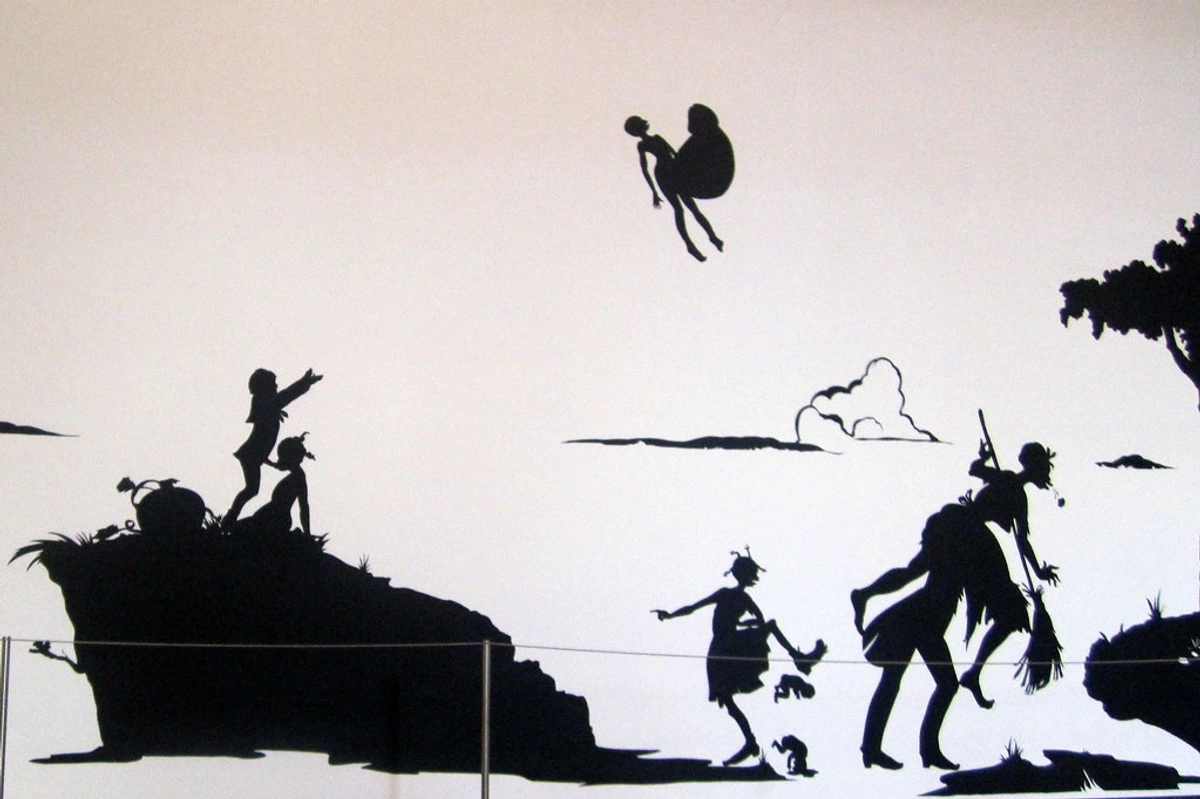
Take a look at the overall shape. It's a strong pyramidal composition, with Marianne, flag held high, forming the apex. This structure immediately draws your eye upwards, elevating her to a heroic, almost divine status, reinforcing the idealism of the cause. But unlike the static pyramids of classical art, this one is moving. The figures surge forward, creating a powerful diagonal thrust from left to right, mirroring the unstoppable momentum of the revolution. It’s an incredibly clever way to infuse a static medium with such a potent sense of forward motion. It makes you feel like you're right there, swept up in the charge! This isn't just about showing; it's about experiencing. The dynamic diagonals created by the figures—from the fallen in the foreground leading up to Marianne and the flag—create a powerful sense of forward momentum. This visual flow, combined with the swirling smoke and active poses, gives the painting a cinematic quality, almost like a freeze-frame from an epic historical drama. The overlapping figures, the varied angles of their bodies, and the dramatic foreshortening all contribute to this sense of urgent, unstoppable movement. It's a composition designed to be felt, not just observed, drawing the viewer into the visceral energy of the revolutionary moment itself, a testament to Delacroix's mastery of visual storytelling.
The Drama of Light and Shadow
Delacroix's use of chiaroscuro is also pivotal. The dramatic lighting, with strong contrasts between light and dark, isn't just for show. It emphasizes key figures like Marianne, making her glow with almost supernatural light, while casting shadows on the fallen, underscoring their tragic fate. This isn't just about visibility; it's about emotional manipulation, guiding your eye and your feelings. And the colors! The bold, vibrant hues of the flag and Marianne's drapery cut through the smoky, somber grays and browns of the battlefield. This contrast intensifies the drama, making the ideals of the revolution stand out against the grim reality of the fight. It's almost like a spotlight on hope amidst despair, a concept I often wrestle with in my own work – how to let light pierce through the darkest abstract compositions. My piece, "Endless Bad Trip," while about a health battle, also explores this contrast.
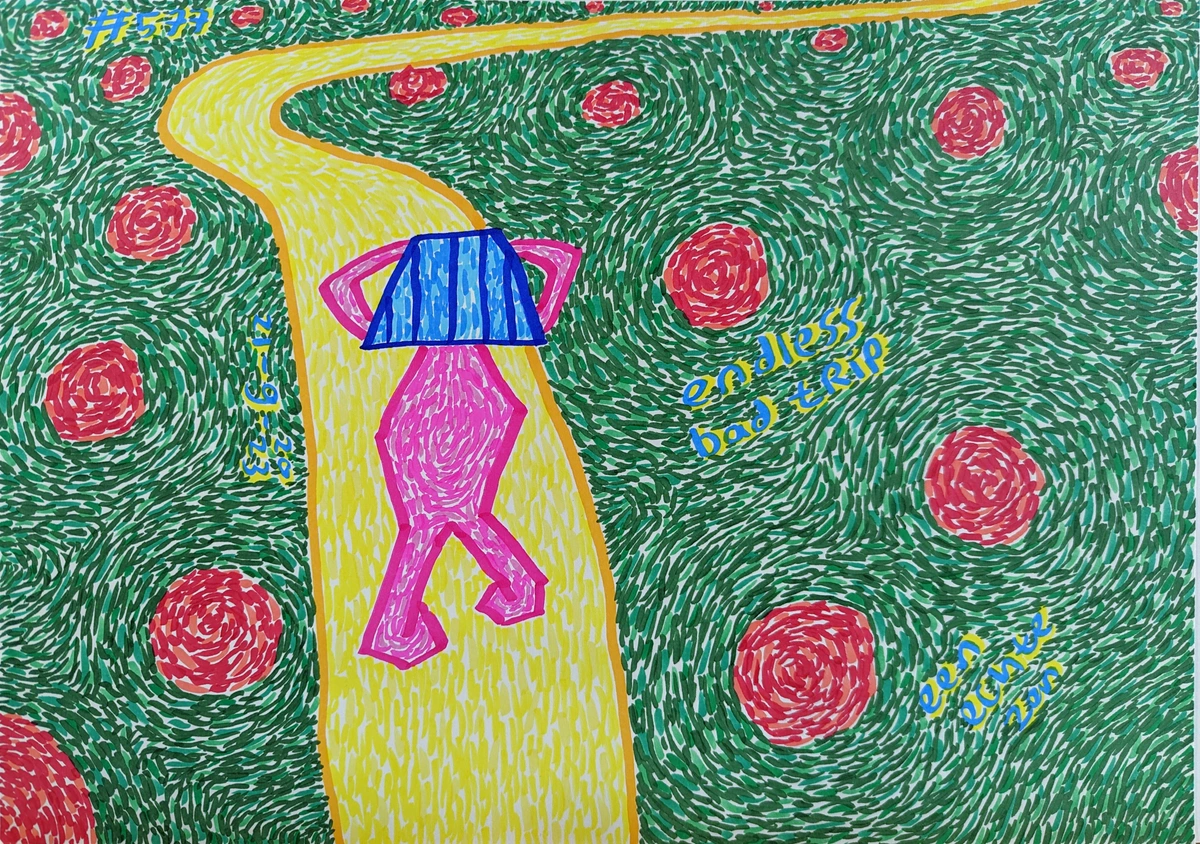
credit, licence "Endless Bad Trip," while about a health battle, also explores this contrast.
credit, licence
Beyond the Canvas: Delacroix's Enduring Legacy
Initial Reception and Controversy
When 'Liberty Leading the People' was first exhibited at the Salon of 1831, it caused a proper commotion, sparking both fervent admiration and significant scandal. While many hailed its revolutionary spirit and celebrated Delacroix's powerful depiction of the popular uprising, others found its raw depiction – especially the bare-breasted Marianne and the gritty street fighters – a bit too… real, too unrefined, and even vulgar for comfort. Conservative critics, steeped in the Neoclassical tradition, found its dynamism chaotic and its subject matter lacking in classical decorum, preferring the stoicism of David to the passion of Delacroix. The government, which initially purchased the painting as a gesture of support for the new July Monarchy, quickly got cold feet. Fearing its incendiary power might spark another rebellion among the populace, they quietly put it away in storage, effectively censoring the artwork. Can you imagine a piece of art being so potent it frightens those in power? It really speaks to the idea of Art as Catalyst for Social Change, doesn't it? For an artist, that's almost the highest compliment – to create something that resonates so deeply it causes a ripple, even a tremor.
The decision to remove it reflected a deep-seated fear of its ability to incite further unrest among the working classes it so vividly depicted. The painting became a potent symbol despite official attempts to suppress it. It wasn't until 1848, during another period of revolutionary fervor (the Spring of Nations), that the painting was briefly displayed again, only to be removed once more. Its journey to public acceptance was a slow one, a reflection of France's own turbulent political landscape throughout the 19th century. It finally found its permanent and celebrated home in the Louvre in 1874, solidifying its status as a national treasure and an undisputed masterpiece, a testament to its eventual triumph over initial controversy and the enduring power of its message. It's a powerful lesson in how art, once unleashed, can carve its own destiny, often defying the intentions of its patrons.
The Legacy in French Culture: Marianne's Enduring Reign
Beyond its initial controversial reception, 'Liberty Leading the People' cemented its place not just in art history, but at the very heart of French national identity. Delacroix's dynamic portrayal of Marianne, the allegorical figure of Liberty, became the definitive visual representation of the French Republic. Her image, popularized by this painting, transcended the canvas to become a pervasive cultural icon.
Today, Marianne's bust adorns every French town hall and court of justice, symbolizing the republican ideals of liberty, equality, and fraternity. She appears on French postage stamps, coins (including the euro coin), and official government logos. This widespread adoption illustrates the painting's profound influence on shaping the visual language of the nation. For many, she is France – a defiant, nurturing, and unwavering symbol of democratic values and the hard-won freedoms of the Republic. Delacroix's genius didn't just paint a moment; he painted an enduring national soul.
Delacroix's Later Career and Enduring Influence
'Liberty Leading the People' cemented Delacroix's reputation as a leading figure of Romanticism and a painter of profound national significance. While the painting itself was initially sidelined, its artistic power and revolutionary spirit cast a long shadow over his subsequent career, and its imagery continued to subtly inform his work. He went on to produce an astonishing body of monumental works, including large-scale decorative commissions for public buildings like the Salon du Roi in the Palais Bourbon and the Library at the Palais du Luxembourg, demonstrating his immense versatility and sustained artistic vision. His mastery of color, dynamic composition, and emotional depth profoundly influenced a generation of artists, laying crucial groundwork for future movements such as Realism and even Impressionism. I sometimes think about how an artist's most famous piece can overshadow their entire body of work, but with Delacroix, 'Liberty' was less a peak and more a launching pad, a bold declaration of his artistic and political convictions that resonated throughout his life and beyond, solidifying his place as a titan of French art.
Delacroix and David: A Clash of Ideals
It’s impossible to discuss 'Liberty Leading the People' without acknowledging the towering figure of Jacques-Louis David, the undisputed master of Neoclassicism, who dominated French art prior to Delacroix. David’s works, like The Oath of the Horatii or The Death of Marat, championed stoicism, civic duty, and a rational, almost sculptural clarity. His lines were precise, his colors restrained, and his compositions orderly, reflecting the Enlightenment ideals of reason and moralizing fables, often drawing inspiration from ancient Roman history and mythology to convey timeless moral lessons. This academic rigor and intellectual detachment stood in stark contrast to the emotional fervor that Delacroix and the Romantics would later champion, creating a dramatic artistic dialogue in France.
Delacroix, however, deliberately broke with this tradition. Where David gave us idealized heroes, Delacroix presented the gritty reality of the street. Where David sought order, Delacroix embraced dynamic chaos. This fundamental divergence wasn't just a stylistic choice; it was a philosophical statement. Delacroix’s Romanticism, with its emphasis on raw emotion, individual passion, and the sublime, offered a powerful counter-narrative to David's cerebral classicism. While both artists engaged with political themes, David often looked to ancient Rome for his moral lessons, while Delacroix plunged into the immediate, visceral present. It’s a fascinating tension in French art history, illustrating how different artistic sensibilities can interpret and reflect the spirit of their times.
When I look at 'Liberty Leading the People', I can't help but draw parallels with other powerful artworks that have captured moments of social and political upheaval. It’s a testament to art's enduring role as a witness, a provocateur, and a chronicler of human struggle, proving that the canvas can be as potent a battleground as the streets themselves. This cross-cultural dialogue between revolutionary artworks reveals a shared human experience in the face of tyranny and a universal longing for freedom.
Picasso's Guernica: A Cry Against War
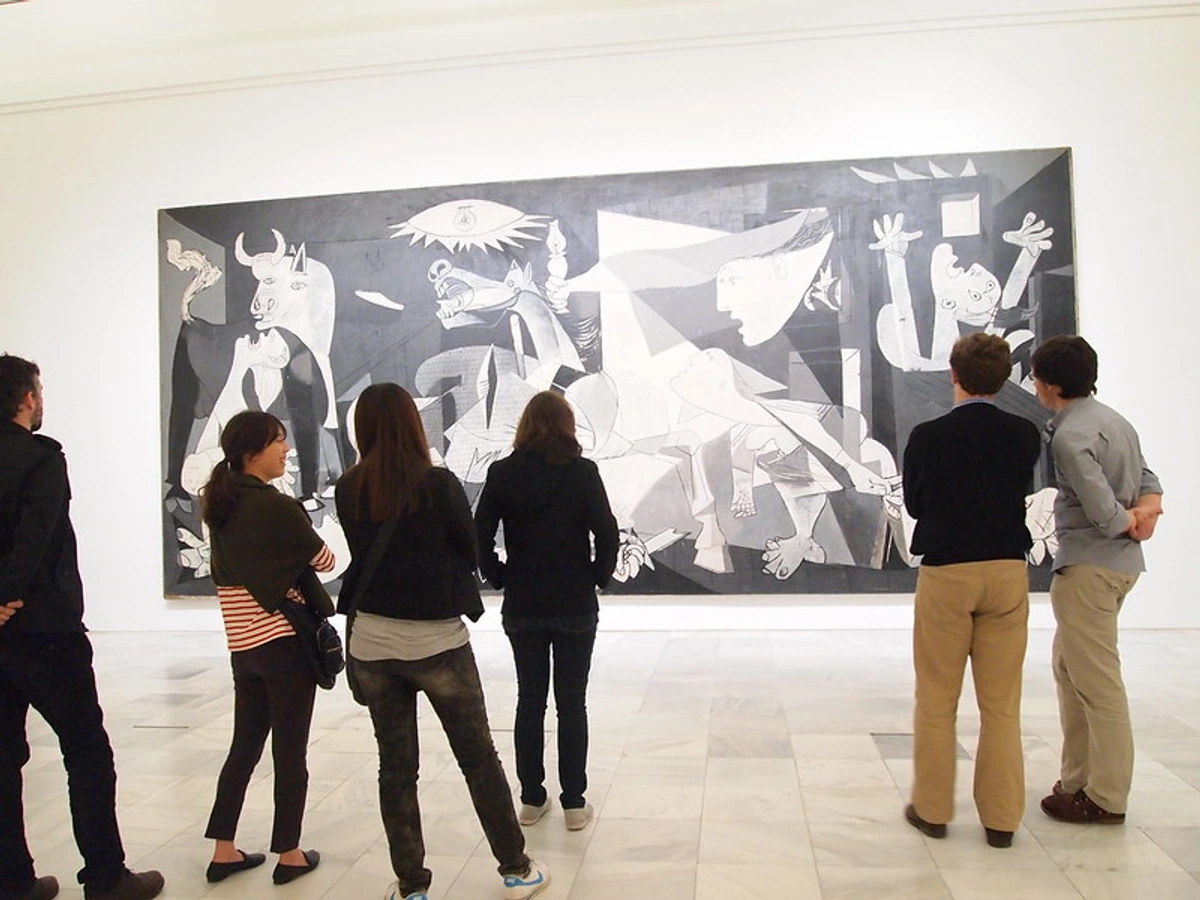
One that immediately comes to mind is Pablo Picasso’s what-is-the-meaning-of-picassos-guernica. While Delacroix's painting celebrates a victorious uprising, Guernica is a harrowing condemnation of the brutality of war and fascism. Its monochromatic palette and fragmented Cubist forms create a sense of utter devastation, portraying screaming figures and dismembered bodies as a universal cry against violence and the senseless destruction of civilian life. Both use allegorical figures and intense emotionality, but where Delacroix's vision is one of hopeful charge and ultimate triumph, Picasso’s is one of fragmented, screaming despair, a raw and agonizing portrayal of suffering. Yet, both powerfully communicate the human cost of conflict and the artist's deeply felt response to their era’s seismic events, using their canvases to not just depict, but to bear witness and provoke thought. They both force you to look, to feel, and to question, demonstrating the diverse ways art can bear witness to historical atrocities.
Mexican Muralism: Art for the People

Another compelling comparison lies with the Mexican Muralist movement of the early 20th century. Artists like Diego Rivera, José Clemente Orozco, and David Alfaro Siqueiros created monumental public artworks that celebrated their nation's history, revolution, and indigenous culture. Much like Delacroix sought to depict "the people" in his work, the Mexican muralists aimed to create an art that was accessible and spoke directly to the masses, often illustrating the struggles of the working class and advocating for social justice. Their grand scale, public display, and direct political messages echoed Delacroix's ambition to create a painting that resonated with the populace, forging a shared spirit of art as a tool for political expression and national identity.
Goya's The Third of May 1808: The Horrors of War
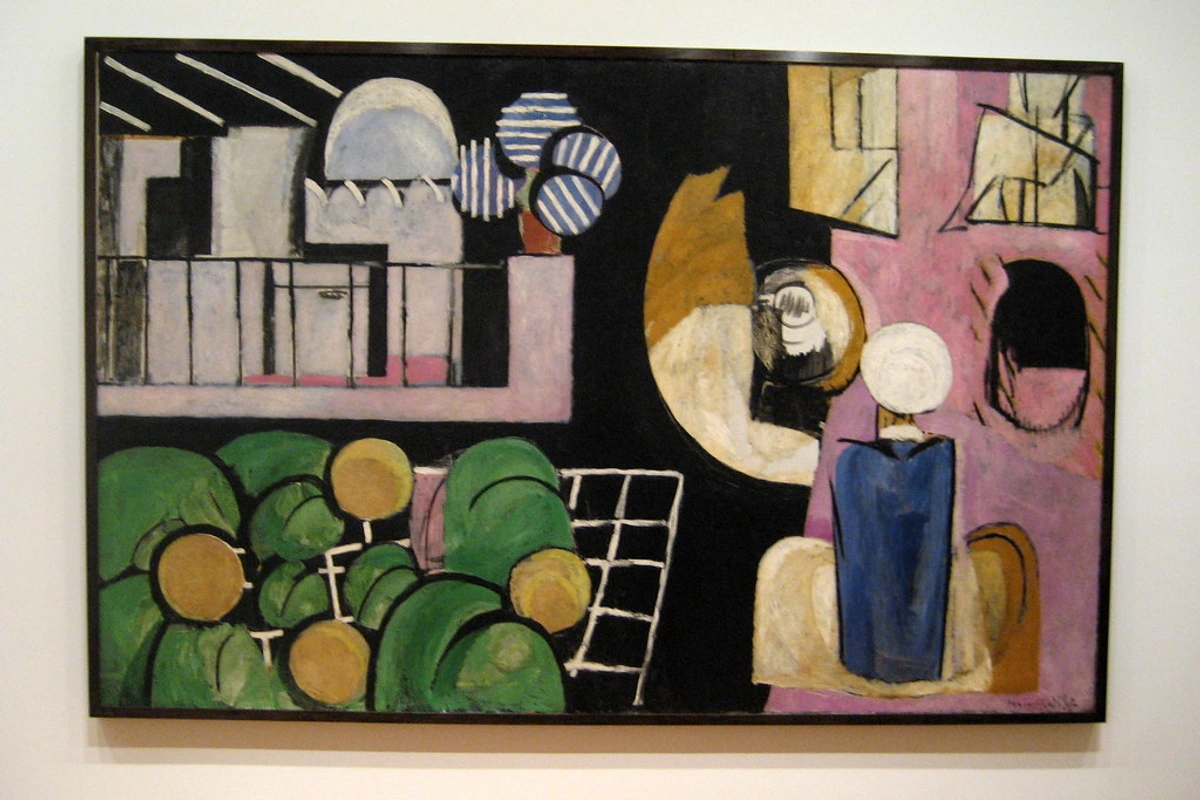
Another powerful precursor and parallel to Delacroix's work can be found in Francisco Goya's The Third of May 1808. Painted just two decades before Delacroix's masterpiece, Goya's work also captures a moment of national uprising and brutal suppression. While Delacroix's Liberty depicts the exhilarating charge towards freedom, Goya's painting is a visceral condemnation of the atrocities of war, focusing on the terrified faces of civilian resistors being executed by French soldiers under a stark, dramatic spotlight. Goya's use of intense chiaroscuro and the harrowing expressions of the victims creates an unforgettable scene of human suffering and injustice. Both artists used dramatic lighting and emotional intensity, but with vastly different aims: Delacroix to inspire, Goya to warn. Yet, both stand as monumental testaments to art's capacity to engage with and reflect political realities.
Courbet's The Stone Breakers: A Glimpse of Social Realism
While stylistically distinct, Gustave Courbet’s The Stone Breakers (1849) offers another fascinating point of comparison, shifting from Romantic idealism to the stark reality of Realism. Painted nearly two decades after Delacroix’s masterpiece, Courbet’s work depicts two anonymous laborers engaged in back-breaking manual work, highlighting the harsh realities of rural poverty. Where Delacroix elevated the working class into heroic revolutionary figures, Courbet presented them as they were, without idealization or allegorical overlay. Both paintings, however, share a profound social commentary: Delacroix celebrated the working class’s fight for political liberty, while Courbet exposed their daily economic struggles. They both insisted on depicting the often-unseen members of society, forcing the viewer to confront difficult truths, though their artistic languages were dramatically different.
Géricault's The Raft of the Medusa: A Precedent in Romantic Grandeur
To truly understand the groundbreaking nature of 'Liberty Leading the People,' it's crucial to acknowledge the monumental influence of Théodore Géricault's The Raft of the Medusa (1818-1819). Painted just over a decade before Delacroix's work, Géricault's masterpiece served as a powerful Romantic precedent, shaking the foundations of academic art and directly influencing the younger Delacroix (who even posed for one of the figures in Géricault's studio!).
The Raft of the Medusa depicted a contemporary shipwreck, a scandalous event that exposed corruption within the French monarchy. Like Delacroix, Géricault chose a grand scale for a modern, politically charged subject. He embraced dramatic chiaroscuro, a dynamic, pyramidal composition that surges upwards, and an intense focus on raw human emotion – despair, hope, suffering, and the will to survive. The painting was a visceral exploration of the sublime, demonstrating how art could confront harrowing contemporary events with an unprecedented emotional intensity and monumental scale. This daring approach undoubtedly cleared a path for Delacroix, showing that a painting could be both historically relevant and emotionally resonant, a powerful indictment of injustice, and a celebration of human endurance. Both Géricault and Delacroix used the canvas to grapple with national crises, transforming specific tragedies into universal statements on the human condition and the failures of authority.
These comparisons aren't to diminish Delacroix's unique vision, but to highlight how art consistently rises to the occasion of historical moments, echoing across centuries and cultures, proving its enduring power to document, inspire, and provoke. It's a reminder that artists, in their unique ways, are often the most potent chroniclers and commentators of their times.
Key Takeaways: Why Liberty Still Leads
'Liberty Leading the People' is far more than just a painting of a historical event. It's a vibrant, emotional manifesto for freedom, a masterclass in Romantic art, and an enduring symbol that transcends its original context. It teaches us about the human cost of revolution, the power of collective will, and the timeless pursuit of liberty. Delacroix’s genius lay in his ability to transform a contemporary uprising into a universal allegory, making us confront what it means to fight for ideals.
It’s a powerful reminder that art can not only document history but actively shape our understanding and emotional connection to it. As an artist, I constantly return to works like this to remember the impact art can have, to see how deep an emotional landscape can be carved onto a canvas, and to be inspired by the relentless pursuit of an ideal, however abstract.
Frequently Asked Questions (FAQ)
Who painted "Liberty Leading the People" and when?
The iconic painting "Liberty Leading the People" was created by the French Romantic artist Eugène Delacroix in 1830. He completed it quickly, driven by his direct experience of the July Revolution, pouring his observations and emotions directly onto the canvas.
What inspired Delacroix to paint "Liberty Leading the People"?
Delacroix was directly inspired by the July Revolution of 1830 in Paris, which he witnessed firsthand. He felt a profound sense of civic duty and artistic compulsion to depict the heroism and passion of the Parisian people fighting for their freedom. His famous quote, "I have undertaken a modern subject, a barricade, and if I have not won for my country, at least I will paint for it," perfectly encapsulates his motivation to contribute to the national spirit through his art.
What specific historical event is depicted in the painting?
The painting vividly depicts the July Revolution of 1830 in Paris, France. This was a three-day uprising (known as "Les Trois Glorieuses") where the citizens of Paris revolted against the authoritarian rule of King Charles X, ultimately leading to his abdication and the establishment of a more liberal constitutional monarchy under Louis-Philippe.
Who is the central female figure and what does she symbolize?
The commanding central female figure is Marianne, an allegorical personification of Liberty and, by extension, France itself and the French Republic. She is not a real historical individual but a powerful symbolic representation of freedom, reason, and the national spirit. Her bare breast symbolizes purity, classical antiquity, and the nurturing spirit of the Republic.
Beyond Marianne, what are some of the most important symbols in "Liberty Leading the People"?
Beyond Marianne, key symbols include:
- The French Tricolor Flag: Represents the republican ideals of liberty, equality, and fraternity, a powerful emblem of the new order.
- The Phrygian Cap: A hat traditionally worn by freed slaves in ancient Rome, adopted as a symbol of freedom during the French Revolutions.
What is the significance of the Phrygian Cap in the painting?
The Phrygian Cap, worn by the worker/fighter to Marianne's left and a prominent symbol throughout the French Revolutions, carries immense historical weight. Its origins trace back to antiquity, where it was worn by freed slaves in Rome, thus becoming a potent emblem of emancipation and liberty. In the context of "Liberty Leading the People," its inclusion immediately identifies the wearer as a revolutionary fighting for freedom from oppression, linking the present struggle to a long history of liberation. It's a subtle yet powerful detail that reinforces the painting's core message.
- The Diverse Figures: A cross-section of Parisian society (bourgeoisie, working class, students, children) united in their fight for freedom.
- Notre Dame Cathedral: Visible in the background, it grounds the revolution in a specific, historical, and deeply French context.
- The Barricade and Fallen Bodies: Represents the grim reality and immense sacrifice inherent in revolutionary struggle.
Why is it considered a masterpiece of the Romantic art movement?
"Liberty Leading the People" epitomizes Romanticism through its dramatic emotion, dynamic and chaotic composition, vibrant colors, emphasis on a contemporary political event, and its heroic, allegorical representation of grand ideals like liberty. It rejects the calm rationality and classical restraint of Neoclassicism in favor of passion, individual heroism, the sublime, and a vivid engagement with the present, making it a definitive work of the movement, a true manifesto on canvas.
What was the government's initial reaction to the painting?
The French government initially purchased "Liberty Leading the People" as a gesture of goodwill towards the new July Monarchy. However, they soon grew uneasy with its raw, incendiary power and its depiction of armed revolutionaries, fearing it might incite further rebellion. The painting was quickly removed from public display and placed in storage, effectively censored, for many years. It wasn't until later in the 19th century that it finally found its permanent and celebrated home in the Louvre Museum, a testament to its eventual recognition as a national treasure despite its controversial beginnings.
Where can I see "Liberty Leading the People" today?
This monumental work is a star attraction at the Louvre Museum in Paris, France. Seeing it in person is an absolutely breathtaking experience, a moment that truly connects you to history and art, much like discovering gems at the Museo del Prado or even smaller, curated experiences at the den-bosch-museum.
How does Delacroix use color and light to convey emotion?
Delacroix masterfully employs dramatic lighting (chiaroscuro) and a carefully chosen color palette to evoke powerful emotions. He creates stark contrasts between the vibrant hues of the French Tricolor flag and Marianne's illuminated figure, which stand out against the smoky, somber grays and browns of the battlefield. This contrast intensifies the drama, making the ideals of the revolution (represented by bright colors) stand out against the grim reality of conflict (muted tones). The strong lighting on Marianne elevates her to an almost divine status, serving as a beacon of hope amidst the chaos, while shadows around the fallen emphasize the tragedy and sacrifice.
How did the painting influence later art and politics?
The painting quickly became a powerful icon, influencing subsequent revolutionary art and serving as an enduring symbol of the French Republic. Its imagery has been widely adopted in popular culture, political movements, and even as a national emblem, demonstrating its lasting impact on both art history and political iconography worldwide. Marianne, in particular, became the definitive personification of France. Its potent visual narrative continues to inspire artists and activists, a testament to the visual-storytelling-techniques-in-narrative-art that Delacroix so masterfully employed. From political cartoons to album covers, its message of defiance and hope remains universally resonant, inspiring countless generations to fight for their own liberties.
Conclusion: The Unfading Flame of Liberty
The iconic imagery of 'Liberty Leading the People' extends far beyond the realm of art history, becoming a truly universal icon. It has permeated popular culture, becoming a widely recognized symbol of revolution, freedom, and national pride across the globe. Its powerful composition and allegorical figures have been referenced, parodied, and reimagined across various mediums, demonstrating its enduring cultural resonance and adaptability. From high art to street art, its message of defiance and hope remains potent. Just consider how it has:

- Political Symbolism and National Identity: The painting’s central figure, Marianne, evolved into the definitive national personification of the French Republic, a symbol of its enduring values. Her image appears on official government logos, postage stamps, coins (including the euro coin), and countless public monuments. She is invoked in political discourse to represent republican values, symbolizing the spirit of democratic ideals and the unwavering pursuit of a free society. It's truly remarkable how one painting can solidify a nation's visual identity.
- Literary References and Inspiration: Victor Hugo's Les Misérables, published decades after the painting, is often cited in conjunction with the painting, particularly the character of Gavroche, who is strikingly similar to Delacroix's Gamin. This cross-pollination of revolutionary spirit between art and literature underscores the depth of its cultural impact, showing how art can inspire other forms of storytelling and embed itself in the collective narrative.
- Music and Film Homages: The painting has inspired numerous musical works and featured prominently in film. Perhaps most famously, the album cover for Coldplay's 2008 album Viva la Vida or Death and All His Friends directly references the painting, reinterpreting its themes for a contemporary audience. Its dynamic energy and emotional charge make it a natural fit for cinematic moments depicting struggle and triumph, a potent visual shorthand for rebellion and courage. You see it subtly in protest scenes, in montages of defiance – it's a visual language everyone understands.
- Advertising and Activism: Its powerful visual language has been adapted in countless advertisements and political campaigns worldwide, used to evoke feelings of liberation, progress, and collective action. From protest posters in Tahrir Square to commercial branding that seeks to tap into a sense of breaking free, the core imagery of a defiant figure leading a charge remains potent, echoing Delacroix’s original intent to stir the public conscience. This widespread adoption illustrates that Delacroix's masterpiece transcends its original historical context, evolving into a universal emblem for the relentless pursuit of freedom and the spirit of rebellion. It's a powerful reminder that truly great art never fades; it simply finds new ways to speak to each generation, continually inspiring, provoking, and moving us.
So there you have it: a journey through one of art history's most electrifying paintings. 'Liberty Leading the People' isn't just a historical document; it's a testament to the human spirit's unyielding desire for freedom. It’s a reminder that liberty isn't given; it's often fought for, sometimes with immense sacrifice. Every time I look at it, I'm struck by its raw energy, its passionate conviction, and the way it distills such complex ideas into a single, unforgettable image. It forces me to wonder about the things we still fight for today, the liberties we sometimes take for granted. What images would we paint now to capture our own struggles and hopes? It’s a powerful thought, isn't it? And perhaps, that's the ultimate meaning of this masterpiece: to make us think, to make us feel, and to remind us of the enduring flame of liberty in all of us. It's a flame that, as an artist, I aim to keep alive in my own work, urging reflection and connection, hoping to spark a little bit of that revolutionary spirit in the quiet contemplation of a canvas, perhaps even inspiring you to explore my abstract art that seeks to capture similar emotional resonance, or see how my art tells a story in the den-bosch-museum.
So there you have it: a journey through one of art history's most electrifying paintings. 'Liberty Leading the People' isn't just a historical document; it's a testament to the human spirit's unyielding desire for freedom. It’s a reminder that liberty isn't given; it's often fought for, sometimes with immense sacrifice. Every time I look at it, I'm struck by its raw energy, its passionate conviction, and the way it distills such complex ideas into a single, unforgettable image. It forces me to wonder about the things we still fight for today, the liberties we sometimes take for granted. What images would we paint now to capture our own struggles and hopes? It’s a powerful thought, isn't it? And perhaps, that's the ultimate meaning of this masterpiece: to make us think, to make us feel, and to remind us of the enduring flame of liberty in all of us. It's a flame that, as an artist, I aim to keep alive in my own work, urging reflection and connection, hoping to spark a little bit of that revolutionary spirit in the quiet contemplation of a canvas, perhaps even inspiring you to explore my abstract art that seeks to capture similar emotional resonance, or see how my art tells a story in the den-bosch-museum.
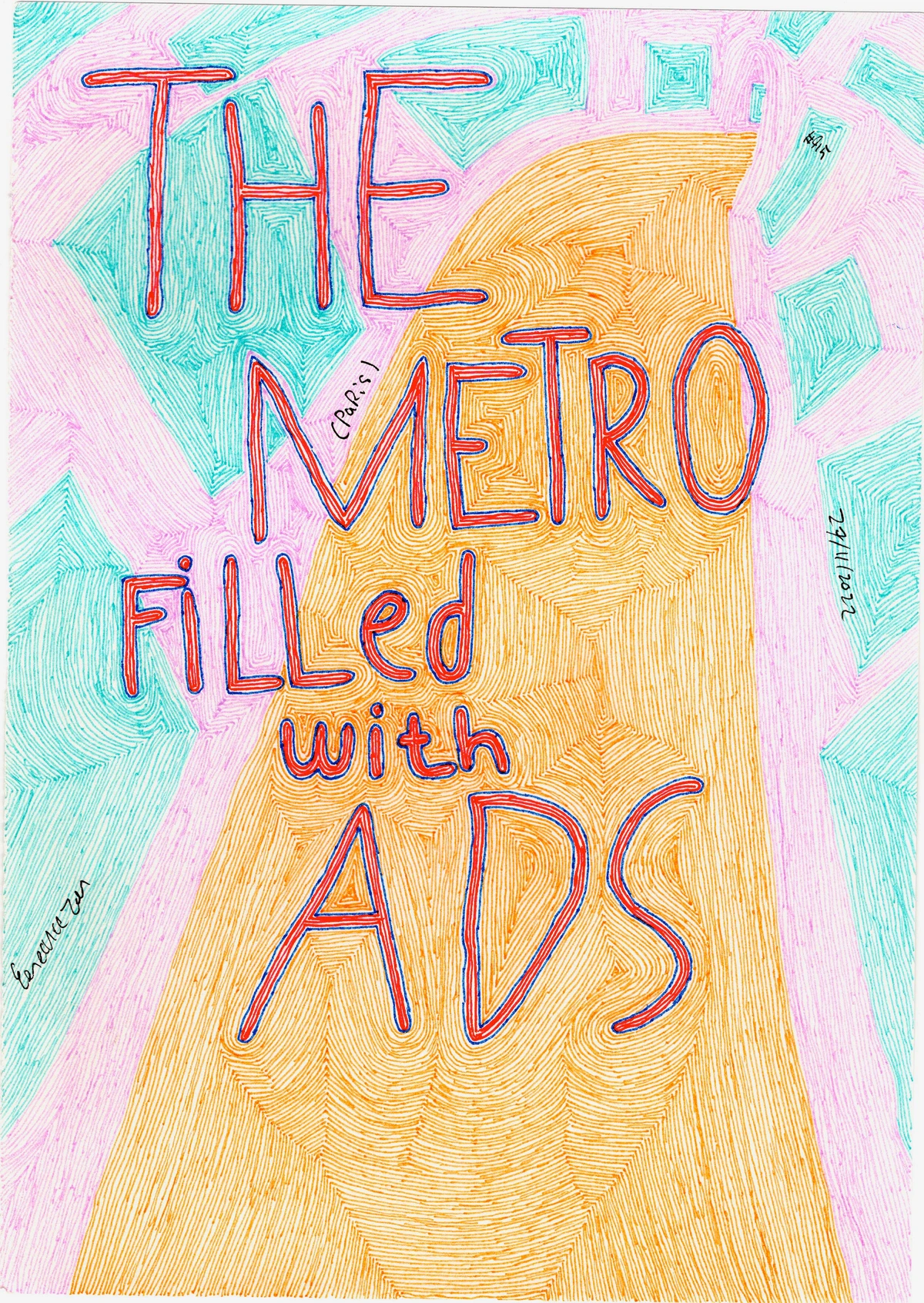
If this exploration has sparked your own curiosity, I encourage you to delve deeper into the works of Delacroix or explore other revolutionary art. Or perhaps, it might even inspire you to consider how your own experiences and aspirations could be translated into art, much like Delacroix translated the tumultuous spirit of 1830 onto his canvas. What stories are waiting to be told through your own unique creative lens? How will you translate the tumultuous spirit of your era onto your canvas, just as Delacroix translated the fire of 1830 onto his?

